Glass Manufacturers’ Marks (logos, trademarks, emblems, markings, signatures) seen on bottles, fruit jars, insulators, tableware and other types of glassware, S through Z listings ~ Note: for introductory and explanatory comments and discussion concerning this alphabetical mark listings section of the website, please click on the “A-B” link below which points to “page one”.
(NOTE: a few “harder-to-classify” marks are listed at the very bottom of this page). Thank you!
[ A – B ] [ C – D ] [ E – L ] [ M – R ] [ S – Z ]
- S (either a “plain capital S” or a graceful cursive script “S” that looks very similar to a treble clef symbol as used in written music)………………………… as seen on the base of upscale tableware and ornamental / decorative glassware including iridescent (Carnival) glass: L. E. Smith Glass Company, Mount Pleasant, Pennsylvania (1907-2007). The cursive S mark was introduced in the 1960s and evidently was used on only a very small percentage of their output. The L.E. Smith factory was closed in June, 2004. Scottish-born Pittsburgh businessman William Kelman purchased the property in 2005 and hoped to revitalize the works, and the factory was apparently able to continue making some more glass for a while, but evidently shut down permanently sometime in 2007 (online sources are contradictory or unclear – can you tell me when the last glass was ACTUALLY manufactured there?). Here is an interesting article about their glass lidded turkey dishes which had been made by L.E. Smith since 1943: https://www.post-gazette.com/life/food/2007/11/08/Born-in-W-Pa-glass-gobblers-hold-tradition/stories/200711080317
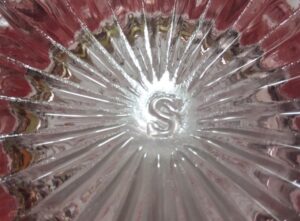
- S (with smaller letters “G” and “C” inserted within the upper and lower spaces/curves of the “S”)………………seen mostly on carnival glass tableware and novelties…….. L. E. Smith Glass Company, Mount Pleasant, Pennsylvania (1907-2007). See entry above.
- S (on the base of handmade antique bottles) ………………….In some cases this mark was used by Lyndeboro Glass Company, South Lyndeborough, New Hampshire (1866-1888). The “S” is seen on the bottom of some hand-blown strap-side liquor flasks (usually in amber or blue-aqua) and certain other bottles which are found in the eastern states. (Thanks to Mark Newton for this info). If the “S” is on a clear bottle, or on a machine-made bottle, that would indicate another maker. Note: as with the great majority of cases involving soda bottles of the late 19th and early twentieth century, if the bottle base has just a large letter, such as S (or any letter, or initials comprised of 2 or more letters) and this corresponds to the initials of the bottling company name embossed on the front of the bottle, that would serve as a self-explanatory meaning, and nearly always does not indicate the glass manufacturer. Many such bottles with an initial on the base were purposely made with no glass manufacturer identification.
- 16S (or with other 2-digit number between 16 and 31)…………..when seen on the base or the heel of early 20th century American-made soda and beer bottles, in most cases indicates production by the American Bottle Company, at their Streator, Illinois plant location. (The “S” stands for Streator). The number usually precedes the letter, but in some cases the order may be reversed, with the number positioned to the right of the letter. These marks were used by ABCO at least during the 1916-1923 period, and evidence from bottle collectors indicate these date code markings may have been used as early as 1905 (when American Bottle Company was incorporated), all the way up to at least 1931, possibly even 1933 in a very few cases. Owens Bottle Company, which purchased the six glass plants of the American Bottle Company in 1916, continued the operation of only two of those ABCO plants (their Newark, OH & Streator, IL locations) under the American Bottle Company name until 1929, and used this type of marking on many of their bottles. Also, see “AB”, “A.B.CO.” and “17N” marks. For more background information and context on these bottles, please see this article written by archeologist Bill Lockhart (along with input from several other researchers). In particular, check out the chart shown on page 347 of the document. This is a .PDF file: https://sha.org/bottle/pdffiles/AmericanBottleCo.pdf
- S in a circle (on colored upscale tableware, NOT utilitarian bottles)……………… said to be one of the marks used by L. E. Smith Glass Company, Mount Pleasant, Pennsylvania (1907-2007). Reportedly, this is a more recent mark used in the 1990s (?). Please see “S” entry at top of this page.
- S in a circle………………………..this mark was used by at least FOUR different glass companies (within the United States) over the years:
*Swindell Bros, Baltimore, Maryland (1869-1959). This was a bottle manufacturer. Reportedly used on machine-made bottles after c. 1920, per Julian Toulouse in “Bottle Makers and their Marks“, 1971.
*Sterling Glass Company, Lapel, Indiana (1914-1950). Hand-blown bottles were produced from 1914 to 1918, at which time semi-automatic production was introduced. Sterling operated as the “Sterling Division” of the Warfield Company of Chicago from about 1940 until 1950. Brockway Glass Company bought the Sterling factory in 1950.
*Southern Glass Company (seen on base of crown-lip soda bottle embossed “Crystal Bottling Works, Tucson, Ariz.)……………………. the meaning of this particular “S in a circle” is open to question, but researcher Bill Lockhart believes it may have been used by Southern Glass Company, Vernon, CA, on a few soda bottles. (Also see “S in a diamond”, below). For more information, see this article from Bill Lockhart et al: https://sha.org/bottle/pdffiles/SMysteriousLetter.pdf
*Sneath Glass Company, Tiffin, Ohio (1892-1894) and Hartford City, Indiana (1894-1952). This particular “S in a circle” mark is most often seen on certain types of glassware including kitchen canisters (storage jars). Sneath operated for a short time in Tiffin but a new plant was built and started glass production in September of 1894. Sneath made a wide variety of types of glassware, including kerosene lamp globes, semaphore signal globes and glass “Hoosier cabinet” jars such as spice jars, coffee and tea jars, salt and pepper sets, etc. The “Hoosier cabinet” jars were especially popular in the 1920s and 1930s. For a much more comprehensive article on Sneath, see the Wikipedia article here: https://en.wikipedia.org/wiki/Sneath_Glass_Company
*ALSO: An “S inside a circle” mark has been seen on the bottom of a white milk glass wide-mouth jar/bottle, possibly connected with the “TANG” brand orange flavored powdered drink mix, and dating from the early 1970s. This piece features a daisy motif encircling the shoulder area of the bottle. The S mark in this case has not been identified with certainty, and was used long after the other glass companies listed above were out of business.
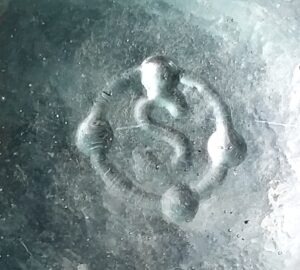
- S in a circle connecting 4 small raised dots, resembling planets arranged in an orbit……………. Uncertain. Seen on the base of a handblown light aqua blob lip “champagne beer” bottle, c.1890-1920. It is possible this mark could be an “S in a circle” and the raised dots might be merely the effect of four air vent holes positioned in the engraved circle portion of the mold. See above “S in a circle” entry.

“S in a diamond” on base of 1920s-era Orange Crush soda bottle, Southern Glass Company, Vernon, CA. (Photo courtesy of Tom K.) - S in a diamond (horizontally oriented, shown above)……………………. On machine-made bottles, Southern Glass Company, Vernon, California (1919-1930). Please also see the next entry. (For more information on Southern Glass Company, see this article by Bill Lockhart et al: https://sha.org/bottle/pdffiles/SouthernGlassCo.pdf
- S in a diamond (vertically or horizontally oriented), on mouth-blown (handmade) bottles, at least in some instances, possibly Swindell Bros, Baltimore, Maryland (1869-1959). Some strap-side type flasks (most commonly found in the Eastern states) bear an “S inside a diamond” mark on the bottom and these are suspected to be products of Swindell Bros. They are typically found in shades of amber, olive green and occasionally citron. Swindell Bros. catalog pages indicate they made several types of liquor flasks in the 1880s-1890s period. HOWEVER, from the collection of papers held at the Winterthur Library pertaining to the career of Chas. Yockel and his glass mold manufacturing firm, there is a letter proving that the Chicago Glass Manufacturing Co., of Chicago, IL, ordered bottle molds with an “S inside a diamond” on November 17, 1887. Evidently both Chicago Glass and Swindell Bros. made large quantities of colorless prescription / druggist type bottles so this presents a problem for accurate attribution! Perhaps more enlightening information will be uncovered as time goes on.
- S in a diamond (the diamond is vertically oriented). As seen on the base of ornately-designed white milk glass dresser tray or shallow dish (part of a “dresser set”), which appears to be from the 1880-1910 time period…………….. Unknown. I am sure this mark has no relation at all to the similar marks seen on bottles. It might stand for the glass manufacturer, or possibly for a distributor/jobber/wholesaler?
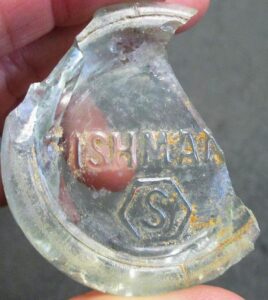
“S in a hexagon” mark on base shard from colorless Fishman or Fishmann bottle – so far unidentified. (Photo courtesy of Carol Serr). - S in a hexagon………………the meaning of this mark is currently unknown. This mark appears on a base shard from a small clear bottle of uncertain purpose partially lettered “FISHMAN”, “FISHMAN’S” or “FISHMANN”. The shard was found in an archeological project in the City Heights area of San Diego in 2013. The bottle appears to have been machine-made, possibly dating from sometime in the 1915-1935 time period. No information about any “Fishman” has been found that seems possibly related, but this might have been a short-lived company operating in California(?). Any information on the identity of this mark is sought! I suspect (but have NO proof of this) that the mark is yet another trademark used by the Southern Glass Company of Vernon, California (greater Los Angeles area). Southern used at least 6 different “S” marks during the 1919-1930 time period when they were in business. Although it is not uncommon for glass factories to go through a few mark variations during their stints in operation, this seems a bit excessive, and it would not be surprising if yet ANOTHER mark could have been used by Southern, if perhaps just for a brief time, or on only one item. Or perhaps the mark is that of an obscure food or beverage distributor? More research needs to be done! (Thanks to Carol Serr for the photograph of this mark, shown above). For more background information on a number of “S” marks, check out this article by Bill Lockhart et al, here: https://sha.org/bottle/pdffiles/SMysteriousLetter.pdf
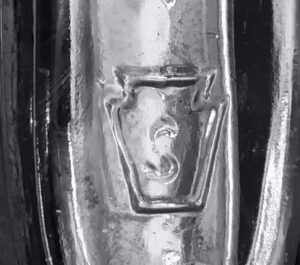
S in a keystone mark used by Seaboard Glass Bottle Company, here on the base of a small aftershave bottle. - S in a keystone (shown above)……………. Seaboard Glass Bottle Company, Pittsburgh, Pennsylvania (1943-1947)
- S in an octagon…………….Sotancro, Embalagem de Vidro, S.A., Lisbon (Lisboa), Portugal . Seen on the base of a miniature green bottle, probably a liqueur, imported to the USA (photo below).
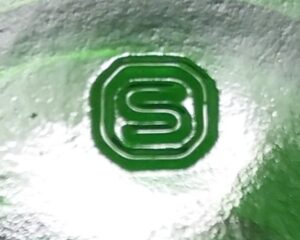
- S in an oval…………..See “G in an oval”. Gallo Glass Company mark might be mistaken for an odd-looking “S”.
- S in a rectangle (confirmed on base of dark olive green “case gin” bottle)………. Unknown meaning. One of these bottles was found with a partial paper label still attached for a gin brand from Rotterdam, in the Netherlands. The bottle is definitely machine made, as the vertical side seams extend up onto the very lip. This mark likely stood for an unidentified glassmaker in Western Europe. The bottle probably dates from sometime in the 1910-1940 time period.
- S in a shield……………..Unknown.
- S in a square……………..Unknown.
- S in a star…………(usually) Southern Glass Company, Vernon, California (1919-1930) if on a machine-made bottle found in the western US. There are also handmade flasks known that appear to be of pre-1900 manufacture, and in such cases, I strongly doubt that Southern is the factory source. Those flasks probably were made much earlier (c.1885-1910) by an as-yet unidentified Eastern U.S. glasshouse.
ADVERTISEMENT
- S.A.B.CO……………American Bottle Company, Streator, Illinois plant (1905-1916). Mark was probably used only for a brief time. Not often encountered, usually the mark is “A.B.CO”. See also “16S” mark.
- Sailboat………………triangular logo vaguely resembling a sailboat with sails unfurled. Please look farther down on this page for the “Triangular Logo” entry: a mark used by American National Can Company.
-
Samco………………. several varieties of “Mason” style fruit jars are known with the Samco brand name, including the Samco Genuine Mason, the Samco Super Jar, and the Samco Super Mason. In The Fruit Jar Works, Volume 2 (Alice Creswick, 1987) she credits these jars to date from circa 1930 to 1940. A trademark for the name “Samco” was issued on November 1, 1931 to the Samuel Mallinger Company of Pittsburgh, PA. The company claimed actual use since August 1, 1931. According to Creswick, the Knox Glass Bottle Company, Inc, of Marienville, PA was the primary manufacturer of these jars, but other possible makers included Glenshaw Glass Company, Glenshaw, PA. and the Ball Bros Glass Company, Muncie, IN. (The “Samco Genuine Mason” jars are virtually identical to “Knox Genuine Mason” jars with the word “Samco” [inside the circle] substituted for “Knox”). Some of the Samco jars came with a metal screw band with milkglass insert marked SAMCO.
- San Francisco Glass Works ……………………… San Francisco Glass Works, San Francisco, California (c.1865-1876). Full name is seen spelled out on the front of some “squat” soda bottles, circa mid-1870s. Originally started by Carlton Newman, and known as San Francisco Flint Glass Works, but after a serious fire in 1868 the works were rebuilt and the name was changed to San Francisco Glass Works. Operated until 1876 when this company merged with Pacific Glass Works to form San Francisco & Pacific Glass Works. A photograph from the 1870s (courtesy of Alexander Kerr) is shown on page 289 of “The Fruit Jar Works” by Alice Creswick (1995), and the photo shows a large display of wares made by this company including fruit jars, wine bottles, beer, ale, whiskey, soda bottles, pickle jars, medicine bottles, and many demijohns and carboys with & without wicker coverings. Most of these bottles probably were not marked, or marked with the user instead of the glass maker. Some are believed to be identified by a characteristic star marking on the base (See “Star” entries on this page).
- Saturn…………………….Occasionally the “Diamond/O/I” mark used by Owens-Illinois Glass Company has been compared to a vague representation of the planet Saturn, or as a cat’s eye. Please check the Owens-Illinois summary page for some pics that show variations of this commonly seen mark.
- S B , along with 1888 patent………………….Swindell Bros, Baltimore, MD (1869-1959).
- SB within a diamond…………..Uncertain, but perhaps Swindell Bros.
- SB (S B), as seen on base of dark teal green wine bottle embossed “Real Vinicola” on front……………… Santos Barosa & Co, Marinha Grande, Portugal. Of course, this mark has no connection whatsoever with Swindell Bros of the United States. Julian Toulouse (Bottle Makers & their Marks, 1971, page 596) lists this manufacturer mark but I don’t know the actual date range for its use. The wine bottle I’ve seen with this mark also bears a label for “Lagosta” Rose table wine, and was imported to the US by Austin, Nichols & Company of New York City, NY. and it looks like it could date from the 1950s or 1960s. The Santos Barosa factory is evidently now part of Vidrala, a large container glass manufacturing company with factories in several western European countries.
- S.B.& G.CO…………………….Streator Bottle & Glass Company, Streator, Illinois (1881-1905). The Streator plant eventually became part of the American Bottle Company, then later Owens Bottle Company, and finally part of the Owens Illinois Glass Company (Plant #9). “S.B.& G.CO.” is one of the most commonly seen marks on handblown beer bottles from the late 1800s and early 1900s. Many, many private brewers and bottlers from the Midwest and eastern United States had bottles specially made for them by Streator. The mark is also seen on other bottles of the period, including pickle bottles, soda bottles and other containers.
- S BROS……………..Possibly Swindell Bros, Baltimore, Maryland (1869-1959).
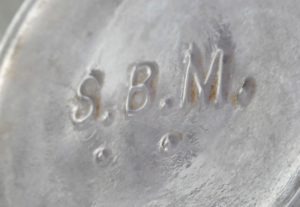
S.B.M. mark on the base of a light amethyst (sun-colored) cylindrical liquor bottle. (Photo courtesy E. Rex) - S.B.M. …………..unknown/unidentified. Reported on the base of both a flask and a cylindrical “fifth” liquor bottle with “brandy” style lip, both in very light amethyst. Appears to date from the 1890-1920 period. This mark might stand for either a distiller or a glass maker.
- S.B.W………………Saltsburg Bottle Works Company, Limited, Saltsburg, Pennsylvania (c.1890-1903), also plants at Avonmore, PA (c. 1893-1904) and McDonald, PA (1900-1904). Best known as a manufacturer of clear (“flint”) druggist bottles. The McDonald plant later became the Warner Glass Company (1904-1911) and then Crescent Bottle Company (see “Crescent Moon” logo entry). The mark “S B W CO” was also used, see next entry. For more detailed background info, see this article by Bill Lockhart: https://sha.org/bottle/pdffiles/Saltsburg.pdf
- S.B.W.CO………………….Saltsburg Bottle Works Company, Ltd., Saltsburg, PA (see above). Lettering has been seen with all 5 letters in one straight line, or with the “C O” placed below the “S B W”, as it appears in the photo here.
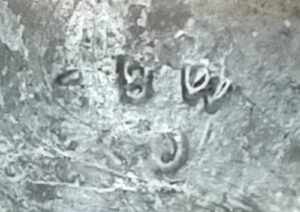
“S B W CO” mark on base of “Husband & Turner” druggist bottle from Modesto, CA (Photo courtesy of John Weismuller) 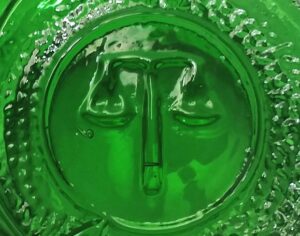
“Scales” emblem used on containers made for McKesson & Robbins. This is on the base of a small green glass jar, perhaps for an ointment. - Scales (embossed image showing a pair of weighing scales, as shown)…………….. Trademark used by McKesson & Robbins, a pharmaceutical / drug company. Originally Olcott & McKesson of New York City, founded in 1833. Business name was changed to McKesson & Robbins in 1853. Other name changes/mergers over the years, currently (2017) known as McKesson Corporation. Many bottles and jars with this design on the bottom seem to be products of Owens-Illinois Glass Company. Often seen in bright emerald green, forest green or “Seven-Up green” glass. I don’t have a timeline when this mark was used on containers, but most of the examples I’ve come across seem to be from the 1930s-1960s era.
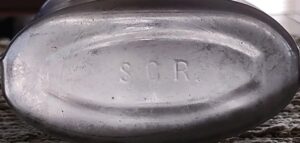
“S C R” (or possibly “S G R”) on base of “Honest Measure” one pint flask (photo courtesy of David Weaver) - S C R (or possibly “S G R”), as seen on the base of clear one-pint strap side flask, double ring finish, marked “HONEST MEASURE” and “FULL PINT” on front………………………… Unknown meaning, possibly a distiller? (Thanks to David Weaver for submitting info on this mark).
- S & D ………………….in most cases, those initials stand for Sharp & Dohme, Baltimore, a pharmaceutical company founded in 1860 that merged with Merck in 1953. The exact period of use of those letters, as embossed on the bases of various medicine bottles, is unclear – possibly during the 1900-1930 era? Also, collector Steve Hale reports a handmade blob-top beverage bottle, evidently made for soda or beer, marked S & D / 112″ on the base. That bottle may have no connection whatsoever with Sharp & Dohme.
- SDS (S D S) ……….. initials seen on the bases of some “U.S.A. HOSP. DEPT.” bottles. These bottles are mouthblown cylindrical utility types usually classed as “chemical” or “druggist packer” bottles. At least four different molds were used to make bottles with the SDS mark on the bottom. They likely date from sometime in the 1865-1880 time period. The meaning of those initials is unknown. A few were found in the archeological excavation at Fort Riley, Kansas in the 1980s. For more information on the bottles found there, check out this article/report by Bill Lockhart and other members of the Bottle Research Group (BRG): https://sha.org/bottle/pdffiles/FortRileyReport2012.pdf
- Seneca (Etched signature on base of drinking glass/tumbler)………….. Seneca Glass Company, Morgantown, West Virginia (1896-1983). Seneca started at Fostoria, Ohio in 1891 and moved operations to a new factory at Morgantown in 1896, starting production there in early 1897. This mark on tumblers probably dates from the 1970s-1983 period. If you have information that narrows down this mark more precisely, please contact me!
- S. F. (on skirt of CD 102 and CD 112 style glass “pony” telephone insulators)…………………….. unknown meaning. There has been much discussion over the years among insulator collectors as to the correct meaning of these initials, but to date no one has proven what they stand for. These insulators appear to date (from their style and “look”) from sometime in the 1900-1915 period, and are found in shades of aqua and green. Many have been found in the western parts of the United States. The most plausible theory points to Fobes Supply Company, an electrical supply company operating in the Western states in the early 1900s. But if that were the case, why isn’t the embossing “F. S.” rather than “S. F.”? Here’s a good article written by the late collector and researcher Frank Swies: https://www.cjow.com/archive/article.php?month=4&a=04SF.htm&year=2006
- S.F.G.CO (or S-F G. Co.) …………………….Sheldon-Foster Glass Company, Gas City, Indiana (1894-c. 1902+) and Chicago Heights, Illinois (c. 1901-1912). This glass company made many druggist bottles that were sold by jobbers including A. M. Foster & Co and Dean, Foster & Company. More info on this page by Bill Lockhart et al: https://sha.org/bottle/pdffiles/Sheldon-FosterGlass.pdf
- S.F.& P.G.W……..San Francisco and Pacific Glass Works (1876-c.1901)
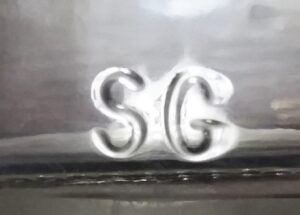
“S G” mark on heel of clear packer jar manufactured by Saint Gobain Containers / Verallia North America. - SG (on modern glass containers ……………………………Saint-Gobain Containers, Muncie, IN [head office], known (2010-2014) as Verallia North America, (mark dates 2000-to mid/late 2010s). Many typical modern glass “packer” jars and bottles found on grocery store shelves here in the United States, such as for jelly, jam, applesauce, etc, bear this mark, usually on the heel of the container, sometimes the base. Verallia North America was bought by Ardagh Group in 2014. For a little more info, see the “U” mark used by Ardagh Group, pictured farther down on this page, and the individual webpages SG mark, and Ball Bros Glass Company.
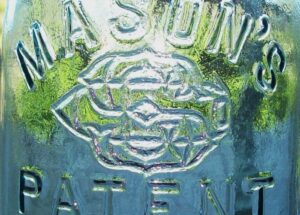
SGCO monogram on front of antique glass MASON’S PATENT NOV 30TH 1858 type fruit jar – Swayzee Glass Company (Photo courtesy Jean Boyer) - SGCo (entwined letters in a monogram) ……………….. Swayzee Glass Company, Swayzee, Indiana (1895-1906). This “S G Co” monogram is seen embossed on the front of certain “Mason’s Patent Nov 30 1858” type fruit jars. The jar variant usually found is listed as jar #1974 in the “Red Book” price guide used by fruit jar collectors. The letters comprising the monogram may be difficult to identify and are often misunderstood by collectors. This marking was attributed to Safe Glass Company, Bowling Green, Ohio; Redkey, Indiana; later, Upland, Indiana, by author Julian Toulouse. Since the publication of his books (1968, 1971), wooden shipping crates have been found with the SGCO monogram identifying it beyond doubt to have actually been used by Swayzee. (Although the monogram on the shipping crates is not absolutely identical to the monogram on the jars, it is very similar, and I don’t think the jars should be attributed, because of that difference, to another company such as Safe Glass Co. Artists doing work for packing crates, letterheads, patent records, etc., in the 1800s often took some liberties with the exact appearance of a design or trademark for a business). All “SGCO monogram” Mason’s Patent NOV 30TH 1858″ jars are handmade with ground lips, which would identify them as early Swayzee production, circa 1895-1898.
- S.G.CO ………………………. Several glass factories used this mark (at least four, probably more) . One fairly strong probable user of the mark was Scranton Glass Company, Scranton, Pennsylvania (1881-c.1895) as there are a number of known types of bottles with embossings of local Scranton businesses which carry S.G.CO. , usually on the reverse heel. No proof that Scranton was involved, but perhaps time will tell. Nevertheless, here are listed four companies that I am certain actually did use this mark, at least on some items they produced:
- ***Seattle Glass Company, Renton, Washington (1905-1907), known for producing amber beer bottles. These are primarily found in the northwestern US.
- *** Severn Glass Company, Annapolis, Maryland (c.1897-1901). Appears on certain bottles (usually flasks or beer bottles in amber or aqua) found in the Baltimore, Maryland and surrounding area. The mark appears on the heel or the base, and in some cases is accompanied by an anchor. Information uncovered by researcher Tod Von Mechow indicate that ths little-known firm is virtually certain to have been the user of S.G.CO. on these bottles. Several dozen different beer bottle variants from Baltimore and surrounding area are known with this mark.
- ***Southern Glass Company/Works, Louisville, Kentucky (1877-c.1885) Frequently seen on the base of “JOHN J. SMITH / LOUISVILLE KY” tonic bottles.
- ***Southern Glass Company, Vernon, California (1919-1930). Mostly machine-made bottles, including clear prescription druggist types, mainly found in the western states of the US. This factory also used several other marks including “S in a circle”, “S in a horizontal diamond” and “S in a star”, on various types of bottles.
- S G CO within a segmented parallelogram…………probably Southern Glass Company, Vernon, California (1919-1930)
- S.G.CO.W……………Sydenham Glass Company, Wallaceburg, Ontario, Canada (1894-1913)
- S.G.CO. with anchor………probably Severn Glass Company, Annapolis, Maryland (c.1897-c.1901). Severn Glass Company was a successor to Annapolis Glass Works, originally incorporated May 12, 1885 in Annapolis. (Per information found by Tod von Mechow).
- S.G.W………………Southern Glass Works, Louisville, Kentucky (1877-c.1885). Base mark, seen on aqua picnic (“pumpkinseed”) flasks.
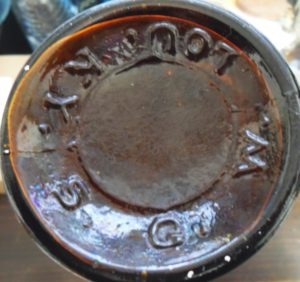
S.G.W. LOU. KY. embossed on base of amber cylinder whiskey – Southern Glass Works, Louisville, KY
- S. G. W. LOU. KY. ………………. Southern Glass Works, Louisville, Kentucky (1877-c.1885). For more information on this glass works, please see my page on Southern Glass Works. For info on some other nearby glassworks, see Kentucky Glass Works Company and Falls City Glass Company, both of which were also located in Louisville and operated during much of the same general time period. Also, see the Star Glass Company which made glass across the Ohio River in New Albany, Indiana.
- SGW (monogram on face of Mason fruit jar)……….Salem Glass Works, Salem, New Jersey (1863-1937), under various ownerships. Jar was probably made in the 1890s to early 1900s.
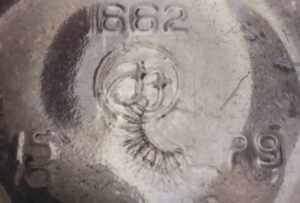
Shear mark on the base of a packer jar made by Foster Forbes (FF in a circle). The shear mark resembles a false eyelash. - Shear mark (minor defect / imperfection on the base of glass articles, created during the manufacturing process). The shear mark is typically “C” or crescent shaped and may be described as resembling an eyelash, fern leaf or feather. Shear marks are commonly seen on the bottom of machine-made bottles, jars, vases, mugs, drinking glasses, etc. Sometimes they are mistakenly believed to be emblems or logos of a specific company.
- Sheets & Duffy, Kensington ………………….Sheets & Duffy, Kensington, Philadelphia, Pennsylvania. (c. 1845- c. 1874). “SHEETS & DUFFY” was embossed on a few historical / figural type flasks including “calabash” type flasks. The flasks with that marking might have been made mostly in the 1860s, although no one seems to be very sure just when they were blown. The operation was evidently one of the earlier factories associated with Dyottville. (See Dyottville Glass Works).
- Sheldon……………….Sheldon-Foster Glass Company, Chicago, Illinois (1895-1913). This mark is evidently less common than the “S-F G CO” mark which was normally used. “SHELDON” appears on the base of a line of prescription bottles, many with personalized slug plate embossings for specific druggists and drug stores. From research by David Bethman, these bottles were most likely made during the c. 1900-1907 time frame.
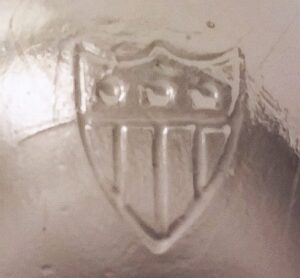
Shield / crest emblem on base of clear jelly glass or tumbler, unknown manufacturer. - Shield (crest) emblem, with 3 dots or stars, one horizontal line & three vertical lines, as shown……………Unknown meaning. The accompanying photo shows the mark as it appears on the base of a clear jelly glass, packer glass or small tumbler (which might have originally been sold filled with mustard, soft cheese, peanut butter or some other food product), probably circa 1900-1930 period.
- Signet……………..Chicago Heights Bottle Company, Chicago Heights, Illinois (1912-1913). Trademark reportedly seen embossed on the base of bottles from this short-lived company. Became part of Illinois Glass Co in 1913.
- Sinclair, A. / Liverpool…………………….. black glass cylindrical utility “wine” or spirits bottle marked “A. SINCLAIR / LIVERPOOL” in a circle on the base was posted on antique-bottles.net by collector Harry Pristis. Evidently “Archibald Sinclair” and later “Archibald Sinclair & Company” operated as a bottle maker in the c.1823- c.1828 period, possibly later, in Liverpool, England.
- S. I. G. W…………….Southern Indiana Glass Works, Loogootee, Indiana (1907-1912). Southern Indiana Glass Works became Graham Glass Company in about 1912, with a factory at Evansville, Indiana. See “Graham”. For more background info on this company, see this article by Bill Lockhart: https://sha.org/bottle/pdffiles/GrahamGlass.pdf
- S.K.& Co.(with star)……..Shields, King & Company (Proprietors of the Newark Star Glass Works, Newark, Ohio (1873-1880). Also, see “N next to or within a star” and “E.H.E.CO.” entries.
- S-K-F (on bottom of cylindrical chemical/pharmaceutical type bottles)………………… Smith, Kline & French Co. (see next entry).
- S. K. & F. CO. ………………… Smith, Kline & French Company, Philadelphia, PA., under that name 1891-c. 1973, with subsequent firm name changes to the present day. Bottles are seen that contained various chemicals and drugs marketed by this pharmaceutical manufacturer. The actual glassmaker of those bottles is unidentified. Whitall Tatum Company could be one possibility. The beginnings of the firm date as far back as 1830, with several name changes, acquisitions and mergers occurring over the years. Because of the different firm names, bottles embossed with the initials shown here (confirmed on the bases of amber cylindrical chemical / medicinal “packer” bottles) could theoretically date from sometime within the 1891-1973 time period, but most likely date before the 1930s. The successor corporation of S K F & Co is presently known as GlaxoSmithKline ( GSK plc, after 2022), based in London, UK. Some more info can be found here: https://en.wikipedia.org/wiki/Smith,_Kline_%26_French and in this pdf file: https://acshist.scs.illinois.edu/bulletin_open_access/v25-1/v25-1%20p16-20.pdf

“C S & L” or “S & L C” mark on base of blackglass bottle. This is a partial base shard of “beach glass”. (Photo courtesy of Peg M.) - S & L C (could be “C S & L” or “S & C L”)………………………………… unidentified mark seen on the base of handmade black glass ale bottles that are almost certainly products of Great Britain. The exact order of the letters is unclear, although I presume the letters are to be read in a clockwise direction, beginning with “S”. This mark probably dates from sometime in the 1860s-1890s. I know of only two reports of this mark (so far), so presumably the glass factory was rather obscure or short-lived, or else they didn’t mark most of their bottle production. Other black glass ale bottles made in Great Britain (and exported to other countries including the US) that are somewhat similar in general “look” would include those marked “C W & Co”, “G W & J”, “Dixon & Co.”, “M C G Y” and “Woolfall Manchester”. The great majority of British black glass ale, stout and wine bottles of this general type are unmarked. The “black glass” is in most cases a very dark olive amber or olive green color, but appears nearly black in reflected light. The bottles were typically made in a three-piece mold, and often have a rather crudely applied lip.
- S M B M Co……………..Standard Milk Bottle Manufacturing Company, Parkersburg, West Virginia (1911-1912). Seen on milk bottles.
- S. M. BiXby & Co………….manufacturer of shoe polish, ink and glue products. Click here for more information: S. M. Bixby & Company bottles.
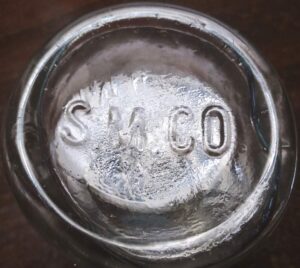
“S M CO” on base of ink bottle – Sanford Manufacturing Company - S. M. CO. …………………….seen on the bottom of many small ink bottles…………….. Sanford Manufacturing Company, later Sanford Ink Company. I suspect most of the bottles marked with these initials date from the 1880-1920 period.
- S. McK. & Co……………See next entry.
- S. McKee & Co…….S. McKee and Company, Pittsburgh, PA (c.1834-1908).
- S. M’Kee…………….S. McKee and Company.
- S. M’Kee & Co…….S. McKee and Company.
- Solar Elect. Co / Chicago / Patd July 11(?) 1905 ………………. embossed marking on the rim of small “forest green” colored glass automobile tail light………………. No information.
- So. Stoddard, N.H…………….see Weeks & Gilson entry.
- SOU.G.W. …………..Southern Glass Works, Louisville, Kentucky (1877-c.1885). Seen on base of wax sealer fruit jar.
- SOU.G.WS. ………….Southern Glass Works, Louisville, KY (1877-c.1885). Seen in a circular formation on bases of several sizes of square pickle bottles (similar to the “cathedral pickles” but with no ornamentation). See “S.G.W. LOU. KY” entry.
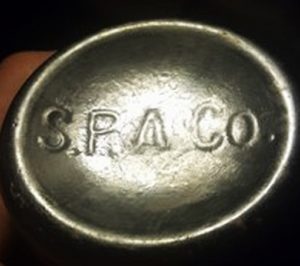
“S.P.A.CO.” on base of ale bottle – unknown meaning (Photo courtesy of Robert Moore) - S.P.A. CO. (on base of amber ale bottle, probably circa 1880s-1890s) as shown above…………………….. unknown meaning.
- Spring Garden Glass Works……………………..embossing seen on early historical / pictorial flasks. This was one of the two factory sites in Baltimore, MD that also operated under the name “Baltimore Glass Works”. (See Baltimore Glass Works entry). There is conflicting information concerning the exact stretch of time the factory was designated with this name, but the flasks with the Spring Garden Glass Works embossing (sometimes the lettering looks more like one word, “Glassworks”) were likely blown sometime during the 1850 to 1870 period. Some flasks from this glass works bear Anchor and Log Cabin designs.
- S & R; S.R & Co……..Southwick, Reeves & Co. (proprietors of the Clyde Glass Works, c. 1868-18??). See Clyde.

S&S -as embossed on base of Bludwine Bottling Company bottle (Photo courtesy of Seth Miller) - S&S (shown)………….. Unknown. Embossed on the base of a Bludwine Bottling Co. bottle, handblown, slug plate, probably circa 1906-1915 era.
- SS in a circle………….Silver Spur Corporation, Cerritos, California (1978-to date). All bottles are actually manufactured in Taiwan and China. Business offices and warehouse is located in Cerritos.
- SSP/B……………..S.S.Pierce, Boston, Massachusetts. Seen on base of strap-side flasks, perhaps 1890-1910 period? Toulouse indicates the maker was possibly S.S. Pierce, a food (and spirits?) distributor based in Boston. Although I was at first skeptical about this attribution, I have since seen one of these flasks carrying a partial label, which was lettered “bottled by S.S. Pierce, Boston”. However, since Pierce was evidently a jobber, the actual manufacturer of the flasks is unknown, presumably a glasshouse in the Boston area.

Star Glass Works star mark (on base of A. Templeton, Louisville, KY cream ale bottle). - Star (5-pointed star on base of handblown bottles, example shown)…………see full article on webpage here: Star Glass Works/Company, New Albany, IN (1869-c.1879). In 1879, W. C. Depauw acquired entire ownership, and the factory then (or soon after) became known as DePauw’s American Plate Glass Works, with the window glass / fruit jar division being called “W. C. DePauw Company” in city directories). The operation produced fruit jars (some are marked “W C D” on the base), and continued to operate until the Panic of 1893 caused the plant to shut down. Sporadic attempts to revive the works failed. This star marking is usually quite boldly embossed, has five points, and has a characteristic “look” that is different from several other types of stars seen on the bases of bottles from the 19th century. Probably the most well-known bottle variant found with this bold, heavy star mark on the base is a “squat quart” Cream Ale bottle made for Alonzo Templeton of Louisville, Kentucky in the very late 1860s and early 1870s. It is found in shades of amber, including orange amber, red amber, and a dark olive amber that looks almost like black glass in reflected light. Note: this is only one type of star. There are other types of stars seen on a wide variety of bottles that have no connection to the firm in New Albany, Indiana. A star on the base of certain bottles found mainly on the west coast might be attributed to Pacific Glass Works, San Francisco, CA (see entry below). Also, see “3 Rivers” and “N next to or within a star” marks. There are also cases in which some types of bottles exhibit a star in the design or on the base which has nothing to do with the glassmaker, usually being a decorative device or a mold identifier. See “W.C.D.” and “X” entries, also see other “Star” entries on this page).
ADVERTISEMENT
- Star (small five-pointed star embossed on skirt of glass electrical insulators). These insulators were marketed by General Electric and are believed to have been made by at least 4 glass companies, three of them located in Elmer, New Jersey. Those glass companies included Sterling, Harloe, and Novelty. Some were also made by Brookfield Glass Company of Brooklyn, NY and Old Bridge, NJ. (According to researcher Bob Stahr, there is no evidence to show that any Star insulators were ever made by Hemingray Glass Company). Some more basic information on these insulators can be found in Brent Burger’s article here: https://www.insulators.info/articles/star.htm
- Star Glass Co. ……………………..Star Glass Company (Star Glass Works, New Albany, IN). Marking embossed across the face of wax sealer style fruit jars. These jars have been found in several colors including shades of aqua, green, citron and amber. See above entry.
- Star enclosing an “N”………..see “N next to (or within) a star”.
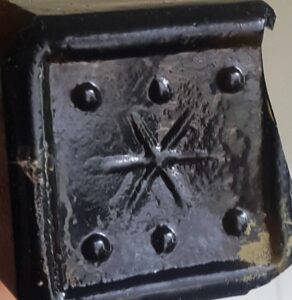
Star or snowflake design on base of olive green case gin bottle (Photo courtesy of Katherine Santer). - Star or “snowflake” design comprised of thin crossed lines (as shown) . This particular photo shows a base shard from a handblown dark olive green rectangular, square-based “Case Gin” type bottle imported to the US from Europe, likely Holland (Netherlands). Many different “crossed lines” designs have been seen on the bottoms of these kinds of bottles. Most of them date, in general, from the 1860 to 1920 period (although that general type of bottle was made as early as the 1620s). Although no one is 100 percent sure of the original purpose of these emblems, they are more likely to have been intended as mere decorative devices, and not glassmakers’ identification marks. See next “star” entry, also see my entry on “X” near the bottom of this page.
- Star (a simple 5-pointed star with the letter C inside, which in some cases the letter may not be clearly visible, on machine-made bottles………………………..some machine-made liquor bottles are seen with this star on the base, along with the liquor bottle permit number “123” and a date code, and these can be identified as having been made by Star City Glass Company of Star City, West Virginia (1948-1966) and Coventry, Rhode Island (1966-c.1976).
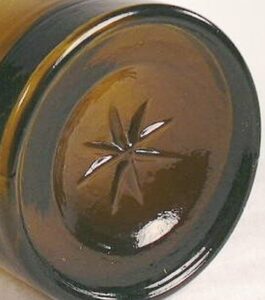
Star mark on base of olive amber cylinder whiskey – Western US glasshouse. (Photo courtesy of Bill Lindsey). - Star (Embossed star design on bases of a variety of bottles, especially cylinder whiskey bottles, known to be Western US glasshouse production)……………………..see photo above. this type of mark is believed to indicate products of one or more bottle factories in San Francisco, California: Pacific Glass Works (1862-1876), San Francisco Glass Works (1865-1876), and San Francisco & Pacific Glass Works (1876-1902) – the star usually has four, six or eight (usually rather thin) points or rays (sometimes more), and looks somewhat similar to the star/snowflake base markings on Dutch Case gin bottles (see entry and photo above). Some bottle diggers have stated the stars are seen on bottles definitely from the early (1860s) era (judging from the context of where found in use layers in dumps or privies), and other sources indicate the star is seen on bottles that date from the 1870s, 1880s and 1890s. Perhaps the star was used on bottles made throughout most of that entire time period? Some bottles with a similar star and with the initials “P C G W” placed in the intervening spaces would be slightly later – Pacific Coast Glass Works (see P.C.G.W. entry). Also see “X” sign, below.
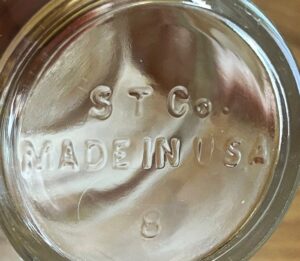
“S T Co / MADE IN USA” on the base of a small clear glass spice jar (Photo courtesy of Stephanie Dougherty) - S T Co. / Made in U.S.A. (as seen on the base of small spice jar or medicine bottle with glass stopper)…………… Unidentified. This might stand for a distributor or housewares company? I suspect this dates from sometime in the 1960s or 1970s. Any info from readers is invited!
- Sterling (“£” – Sterling or “British Pound” sign, as seen on glass electrical insulators) …………………. Sterling Glass Company, Elmer, New Jersey (1902-1903).
- Sterlinglass (written as one word)…………………….Sterling Glass Company, Lapel, Indiana (1914-1950) . This name, presented in cursive script, has been recorded on a number of containers including packer jars (probably made for coffee), ketchup bottles and amber chemical/medicine type bottles. There are probably many others that have gone unreported, as these typical kinds of utilitarian bottles were usually discarded after being emptied. The factory at Lapel was purchased by Brockway Glass Company in 1950. It is possible that some of these containers bearing the “Sterlinglass” mark are products of Brockway Glass Company, after 1950. See “S in a circle”.
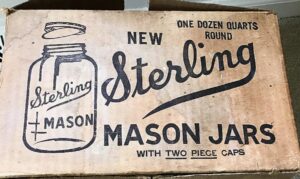
Original Sterling Mason fruit jars shipping box. This dates from before 1950. (Photo courtesy of Wanda Yoder) - Sterling Mason………… fruit jar made by Sterling Glass Company, Lapel, Indiana, and later by the Brockway Glass Company after they acquired the factory at Lapel in 1950. See “Sterlinglass” and “S in a circle” entries.
- St. L. G. W. (on face of clear mouthblown nursing bottle)………………… these initials probably stand for the St. Louis Glass Works, St. Louis, Missouri (c.1861-1888) although concrete proof is (so far) lacking. The bottle also carries the letter “C” on the base. That letter might stand for John K. Cummings, one of the proprietors (and later, the sole proprietor) of the St. Louis Glass Works. (See my entry for “C” on page two). This bottle is shown in this article by Bill Lockhart and the Bottle Research Group (page 314): https://sha.org/bottle/pdffiles/SOther.pdf
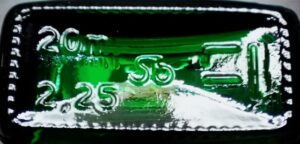
STo mark used by Stoelzle Group (on base of small Jägermeister bottle) - STo (Logo as seen on base of green miniature Jagermeister bottle. The mark may be very small and might be reminiscent of “Sb” or “56” at a quick glance)………………Stoelzle Glass Group, multinational glass manufacturer based in Austria. Factories in Köflach, Austria (Stoelzle Oberglas); Knottingly, West Yorkshire, England (Stoelzle Flaconnage Ltd.); Masnières, France; Monaca, Pennsylvania, USA (since 2021), also with locations in Poland and Czech Republic. https://www.stoelzle.com/corporation/history/
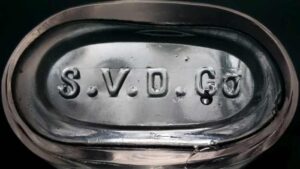
“S. V. D. Co.” mark on base of clear mouthblown druggist bottle – The initials almost certainly stand for Saginaw Valley Drug Company of Saginaw, Michigan, circa 1899- c. 1915 or later. - S. V. D. Co …………………………. Seen on the base of a clear tooled-lip mouthblown prescription/druggist bottle. From recently uncovered information, the initials most likely stand for the Saginaw Valley Drug Company of Saginaw, Michigan, a wholesale drug manufacturer and jobber. They made and/or sold a wide variety of drugs, chemicals, and such products as lemon and vanilla extracts. They were in business at least as early as 1899, in business until c. 1915 or later.
- Swayzee Improved Mason…………………. Swayzee Glass Company, Swayzee, Indiana (1895-1906). Factory bought by Ball Bros. in 1906. Lettering embossed across the face of machine-made (smooth lip) Mason-type fruit jars. These would have been made sometime during the 1899-1906 period. Earlier jars made by Swayzee (presumably hand made, with “ground lips”) are probably the “MASON’S / PATENT / NOV 30TH / 1858” types found with the “S G CO monogram” on the front. (See S.G.CO. monogram).
- S. W. G. Co (initials seen on heels or bases of aqua mouthblown bottles including “Codd” style mineral water / soda bottles)……………South Wales Glass Company, Newport, Wales, United Kingdom (1886-circa early 1920s?). This operation was also known as South Wales Glass Manufacturing Company, Crindau Glass Works, and Newport Glass Works. This webpage includes some excerpts of period newspaper articles on the glassworks: https://www.newportpast.com/gallery/prints/Crindau_Glassworks.html
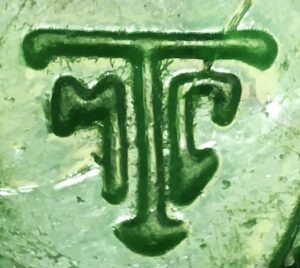
Thatcher Glass “MTC” mark on emerald green “beach glass” shard from a juice bottle. - TMC or MTC (large letter T, vaguely resembling an anchor with horizontal upper stroke, with smaller, angular M and C nestled underneath to the left and right, arranged in a somewhat triangular formation, as shown above, this mark used 1944- c.1983)……………………. Thatcher Glass Manufacturing Company. This mark appears on huge numbers of containers of all types. For more information on this and other marks used by Thatcher, please see Thatcher Manufacturing Company/Thatcher Glass Mnfg. Company .
- T (on mouthblown bottles only)…………………………….almost certainly Tibby Brothers, Pittsburgh, PA (1866-1880) and Sharpsburg, PA (1872-c. 1915). Seen on the base of a small, clear, handmade, otherwise unmarked glass bottle (a bit heavy for its size), possibly 1890s or early 1900s. This bottle closely resembles the perfume bottles marked “Lubin” and “Hoyt’s”. Many other colorless bottles of various types have also been recorded, including small “generic” druggist bottles, and the most likely manufacturer appears to be Tibby Brothers. See the article by Bill Lockhart (linked to in the “T” entry below). Also, see “T.B”. mark.
- T (on machine-made bottles)………………… probably Toledo Bottle Company, Toledo, Ohio (1916-1920). Research by Bill Lockhart indicates Toledo is the most probable source. For more info on the various “T” marks, see https://sha.org/bottle/pdffiles/TibbyToledoGlass.pdf
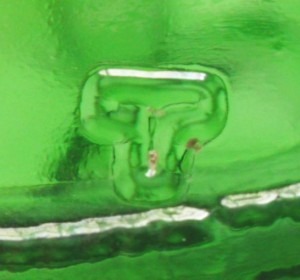
T (Double-line font) used by Thatcher Glass (c.1983-1985) - T (double-lined letter, shown at right). This was the very last logo used by Thatcher Glass Manufacturing Company.
- T in a circle…………….Unidentified, but possibly Toledo Bottle Company, Toledo, Ohio (1916-1920). Seen on base of aqua rectangular paneled prescription bottle, machine-made, c. 1910-1930. The “circle”, (or, more accurately, two circles, one of which may be off-center in the case of this particular “T” mark), is evidently a diagnostic “signature” mark caused by the O’Neill semi-automatic type of bottle-making machine used by Toledo Bottle. See also the “T” entries.
- T in a keystone……..Knox Bottle Company, Palestine, Texas glass plant location (1941-c.1953).
- T in a square (rectangle)………….. Anchor Hocking mark “Anchor in a rectangle” somewhat resembles a capital T when viewed upside down.
- T in an inverted triangle…………..Turner Brothers Company / Turner Glass Company, Terre Haute, Indiana (c.1910-c.1929). This Triangle-T mark was seen on the bottom of a clear glass handled jug, of a type frequently used for vinegar and apple cider. Also seen on a variety of packer bottles such as for ammonia and other chemicals. The mark is seen on some Edison Battery Oil bottles. (Travis Glass Company also used a similar mark, but only used it on milk bottles – see next entry). Successor to Modes-Turner Glass Company. This mark was trademarked with the US Patent & Trademark Office, as No. 205,166 , claiming first use in January of 1920. Turner Bros. was apparently briefly reorganized as Turner Bros. Corporation (c. 1930-1932), later bought by General Glass Corporation (headquartered at Lancaster, OH) with glass bottle manufacturing plants at both Terre Haute and Winchester, Indiana. General Glass Corporation lasted until around 1937 (some info from Indiana Glass Factories Notes, Dick Roller, 1994, page 103) and used a “G inside a diamond” mark on its ware. For more background info, see this article: https://sha.org/bottle/pdffiles/TurnerGlass.pdf
- T in an inverted triangle………….Travis Glass Company, Clarksburg, West Virginia, as seen on milk bottles , circa 1913-1919. Any bottles with this mark that are NOT milk bottles can be attributed to Turner Bros (above).
- T.A. Evans / Pittsburgh PA……………………….. Thomas A. Evans, Pittsburgh, PA (c. 1855-c. 1860). See on base of “MASTODON” fruit jar.

“T. A. EVANS & Co / PITTS PA” on base of light aqua liquor flask (Photo courtesy of Jack Klotz). - T.A. Evans & Co. / Pitts. PA………………………… Thomas A. Evans & Company, Pittsburgh, PA (c. 1860-c.1869). A slight reorganization of the previous firm. For more info see this article by Bill Lockhart et al: https://sha.org/bottle/pdffiles/TOther.pdf
- T.B. ………………Tibby Brothers, Pittsburgh, Pennsylvania (1866-1880) and Sharpsburg, PA (1872-c. 1915). See the “T” entry, above, and the link there to an article by Bill Lockhart on the various “T” and “TB” marks that have been seen.
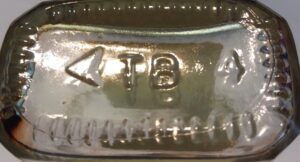
Triangle/Arrow TB mark (on base of labeled Watkins Vanilla Extract bottle) - TB (placed to right of embossed triangle or “left-pointing arrow” logo)……..seen on base of clear machine-made WATKINS / TRIAL MARK extract/flavoring bottle, probably circa 1990s-2000s. Uncertain meaning.
- T.C.W. ………………..See next entry.
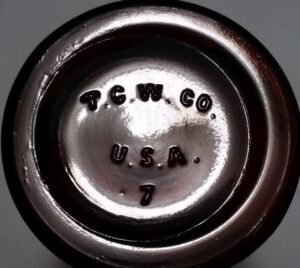
T. C. W. Co. / U.S.A. mark on base of amber glass laboratory chemical bottle made by T. C. Wheaton Company. The “7” is a mold number. - T.C W. CO. …………. T. C. Wheaton Company, later Wheaton Glass Company , Wheaton Industries, Millville, New Jersey (1888-to date). These initials are frequently seen on the bases of clear and amber glass laboratory, chemical, scientific and drug bottles that appear to date from the very early through mid-20th century, although Julian Toulouse listed the mark as dating from 1888. Many of these bottles were sold with a glass stopper, carefully ground to fit the bottle. See “W in a circle” and “Wheaton” entries.
- Teardrops (logo consisting of two teardrops or water droplets, placed alongside each other in the orientation reminiscent of “69” or two “commas”, as seen on the base of drinking glasses / tumblers)……………………. trademark indicating the brand Paşabahçe, made / sold by Şişecam, Istanbul, Turkey. Please see “Drops / droplets” entry on page two.
- Temperglas ……………… Brand name used by Brockway Glass Company. Please see “B in a circle” entry.
- Three Rivers……………..Three Rivers Glass Company, Three Rivers, Texas (1922-1937)
- Tibby Bros Pitts PA….See “T B”.
- 3 R “star”………….Three Rivers Glass Company, Three Rivers, TX (1922-1937)
- 3 Rivers (with “star” emblem)……….Three Rivers Glass Company, Three Rivers, TX (1922-1937). Ball Bros. Glass Company bought this plant in 1937, and operated it for around 10 years before shutting it down.
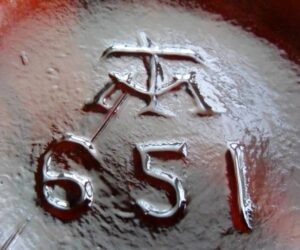
Modes-Turner “TM” monogram (on base of Hoster, Columbus, Ohio beer bottle) - T/M entwined (monogram, as shown)……………… Modes-Turner Glass Company, Cicero & Terre Haute, Indiana (c.1902-1905). Earlier known as Modes Glass Company (1894-c.1902) although both company names may have been used somewhat interchangeably for a time. Terre Haute operation later known as Turner Bros. Glass Company (c.1905-1930) and the Cicero plant became known as Indiana Bottle and Glass Company (c.1905-1909).
- T M C………………Thatcher Manufacturing Company, Kane, PA; Elmira, NY; other locations (1904-1985). Mark used circa 1910s-1920s.
- T MFG CO……………Thatcher Manufacturing Company, Kane, PA; Elmira, NY; other locations (1904-1985). Mark used circa 1910s-1920s.
- T.M’F’G.CO………….Thatcher Manufacturing Company, Kane, PA; Elmira, NY; other locations (1904-1985). Mark used circa 1904-c.1920.
- TRADEMARK / KEYSTONE / REGISTERED (across face of clear wire bail type fruit jar)………. Elk Flint Bottle Company, Shinglehouse, Pennsylvania (1904-1912 or 1919), see E.F.B.Co mark.
- TRADEMARK LIGHTNING PUTNAM ………………..see this page with more information: Trademark Lightning Putnam Fruit Jars.
- Treble clef sign (actually a cursive, capital “S” but looks something like the treble clef in sheet music) …………………lightly embossed on the base of tableware including tumblers, etc: L. E. Smith Glass Company, Mount Pleasant, Pennsylvania (1907-2005) . See “S”, at the top of this page.
- Triangle (inverted, with point oriented downward) and with horizontal line through center………………….. Vidrio Formas, S A de C V, Lerma, Mexico (1990-to date). Photo shows mark as it appears on the base of a Jose Cuervo tequila bottle.
- Triangles (two concentric triangles or “double triangle”) ……………………..emblem seen on the base of small cobalt blue ointment jars, in several sizes. These jars contained Vicks Vaporub, a salve packed in glass jars up until 1983. Please see this webpage: Cobalt Blue Vicks Vaporub jars.
- Triangular logo (shown)…………………………… National Can Company (c. 1985-c. 1988) , this mark used after NCC was purchased by Triangle Industries in 1985. Vaguely resembling a sailboat with sails unfurled, the mark is seen
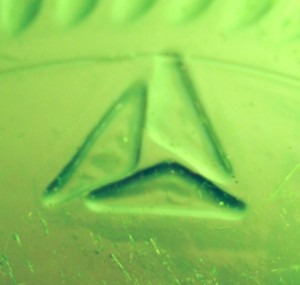
American National Can Company mark, triangular / sailboat logo on the base of soda bottles, such as typical emerald green non-returnable 7-UP or Sprite bottles. Another mark (vaguely resembling two “C’s” or “tin cans” facing each other), was also used by this firm (then named American National Can Company), and according to a post by William Lape (see Comments section of this page), was used from 1988 to 1995. (See “American National Can Company” entry on page one with photo of the other mark). American National Can Company was acquired by Rexam in the year 2000.

Triangle in circle mark (on heel of Clearly Canadian beverage bottle) - Triangle inside a circle (as seen on the heel of a light blue “Clearly Canadian” flavored soda water bottle, bearing a 2019 date code)…………….. Unidentified at the present time. If you have information on the identity of this bottle maker, please help! I am assuming it is the mark of a glass company located in Canada.
- T over a V……………….Tygart Valley Glass Company, Grafton, West Virginia (1895-1928) and Washington, Pennsylvania (1928-1959). A maker of many types of generic packer jars and bottles. Their mark underwent some subtle changes over the years, and the last variant, which closely resembles a narrow inverted triangle,(with the downward-pointing serifs of the “T” crossbar almost, but not quite, touching the upper portions of the “V”) , was evidently used from about 1940 to 1959. On earlier items the mark is reported (by Toulouse) to have had a somewhat wider “V”. Tygart Valley was purchased by Brockway Glass Company in 1959.
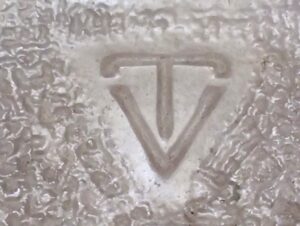
T over V mark used by Tygart Valley Glass Company, circa 1940-1959 - T W (T over a W monogram), shown below………………………… Unidentified. This mark appears on the base of a handmade dark green crown-lip soda or beer bottle, possibly British (?), found while diving in Puget Sound.

TW (monogram) as seen on dark green crown-top soda or beer bottle (Photo courtesy of Jim Minor) - T.W. & CO. …………….Thomas Wightman & Company, Pittsburgh, PA (c. 1873-1893). This mark is seen on fruit jars and a variety of other bottles. One example would be an aqua bottle embossed “W. M. Sowders / Kentucky Sauce” which is very similar in appearance to the commonly-seen older style “Lea & Perrins Worcestershire Sauce” bottles. Another type of bottle made by T.W. & Co. is marked “Louis Weber & Co. / Louisville, KY”, a “squat” ale variant. This company was a successor to Lorenz and Wightman (also please see L & W, W.G.CO, and W marks). For more background information on Thomas Wightman and related companies, see this article by Bill Lockhart: https://sha.org/bottle/pdffiles/WightmanGlass.pdf
- T. W. D. …………………. Kensington Glass Works, Philadelphia, Pennsylvania (1816-c.1833). These initials (standing for Dr. Thomas W. Dyott, part or full owner of the works by around 1821) appeared on a few early historical flasks produced by Kensington in the early 1820s. Helen McKearin (American Bottles and Flasks and their Ancestry, 1978) believed they dated from around 1824 – 1826. See “Kensington Glass Works” and “Dyottville Glass Works” entries.
-
ADVERTISEMENT
- U……………………..Several possibilities: Underwood Glass Company, New Orleans, Louisiana (1956-1978) & Memphis, Tennessee; Upland Cooperative Glass Company, Upland, Indiana (1899-1909) or Upland Flint Bottle Co/Upland Glass Co, Upland, Indiana (1912-1929). In the case of some earlier handblown strapside flasks which are found with a “U” on the base, which probably date before any of these companies’ existence, the glassmaker is uncertain………….perhaps Union Glass Works, Philadelphia, PA (c. 1845-c.1876).
- U in a keystone……………….attributed to Pennsylvania Bottle Company, Sheffield, Pennsylvania (1929-1951). Although this mark was listed in Julian Toulouse’s Bottle Makers and Their Marks (1971), page 506, the mark seems to be unverified (as of 2024). If anyone has actually seen this mark on the base of any bottle or jar, please contact me at the email address listed on the Contact Information page. Also please see my entry under “V in a keystone” on this page. For much more detailed information on the various Keystone marks with letters inside, check out this article by Bill Lockhart et al: https://sha.org/bottle/pdffiles/KnoxGlass.pdf
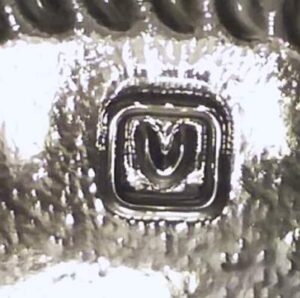
“U inside a Square” trademark. (This mark is actually a “V in a square” and stands for Verallia) - U inside a square (shown above, as it appears on the base of a small ten-sided jar containing Bonne Maman brand wild blueberry preserves). This may be a recently introduced mark (seen February 2021) and probably stands for a glass container manufacturer located in Europe. UPDATE 8/8/2021: I was told (by a reader named Roland) that this is actually a letter “V” and is the current mark being used by Verallia.
- U (symbol which vaguely resembles the letter “U” , a horseshoe, or an upside-down version of the Greek letter “Omega”…………………… Ardagh Group (pronounced AHR-DAW), originally based in Dublin, Ireland, with headquarters now based in Luxembourg, with many bottle manufacturing plants across Europe including Germany, Denmark, United Kingdom, Poland, Netherlands, Italy and Sweden. On most bottles, a number is placed to the immediate right, and that number denotes the factory that produced the glass. (For instance “U 31” seen on the heel of a Heineken green beer bottle indicates production at Ardagh’s bottle factory at Moerdijk, Netherlands). Ardagh began as the Irish Glass Bottle Company, Ltd in 1932, changing the name to Ardagh PLC in 1989. NOTE: In the year 2014, Ardagh Group acquired the former Saint Gobain / Verallia glass factories in the United States, and this mark has since come into use on jars and bottles made at those plants. Thirteen glass container plants in the US are currently (as of 2021) under Ardagh Group ownership and it is my understanding they are all using this logo on their container glassware. (See the list of those 13 plant locations on the Ball Bros. Glass Manufacturing Company page). The logo design is an abstract representation of a chalice, loosely patterned after the celebrated ancient Ardagh Chalice found in Ireland. The mark usually appears on the lower “heel” area of containers but sometimes on the base. According to trademarkia.com, this logo was officially registered as of November 11, 2014. Also, please see the S G / Saint Gobain page.
- U D CO ………….United Drug Company, headquartered in Boston, MA (1902-1944), renamed Rexall Drug Company. Various medicine bottles with this mark on the bottom are known, with possibly the majority of them dating from the first two or three decades of the company’s existence. I don’t know what glass company/companies actually manufactured the bottles for United Drug, but Whitall Tatum Co., and other large bottle makers on the East Coast would be possibilities.
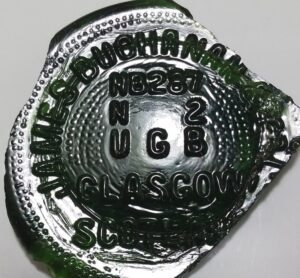
“U G B” on dark olive green base shard from “James Buchanan & Co” scotch whiskey bottle, circa 1950s. - U G B ……………………………… United Glass Bottle Manufacturers, Limited (large conglomerate of many glass factories in the United Kingdom). This mark dates from 1913 to about 1968 and is found on the bases of innumerable bottles of many styles and sizes that were made in Great Britain. UGB included glass factories located at Ravenhead, St. Helens; Sherdley, St. Helens; Portobello, Scotland; Charlton, London; Shettleston, Scotland; Castleford, Yorkshire; Harlow, Essex; New Cross, London; Brimsdown, London; Kinghorn, Scotland; Alloa, Scotland and Peasely, St. Helens. The history is confusing and some factory locations operated for a very long time but others were relatively short-lived. For more detailed background information and history on the factories involved and other marks used, please see this article written by Bill Lockhart et al: https://sha.org/bottle/pdffiles/UnitedGlassBottle.pdf
- U.G.CO……………..Union Glass Company (Works), Philadelphia, Pennsylvania (1845-c.1876).
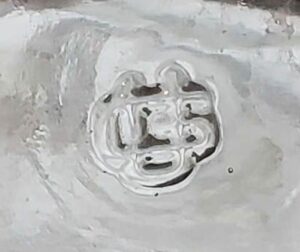
“UG” monogram used by Universal Glass Products, on base of flask (photo courtesy of Vito Miller) - U G (letters entwined in a monogram, shown above)……………. Universal Glass Products (see next entry).
- U G P ……………… Universal Glass Products, Parkersburg, West Virginia (1919-c.1979). Known for producing clear glass milk bottles for various dairies, especially in the 1920s-1950s. The “U G P” mark is typically followed by a “51” and this usually appears on the heel of bottles. National Bottle Corporation acquired the plant in 1960. Julian Toulouse (Bottle Makers and their Marks, 1971) also shows a “U G” monogram (U and G entwined) on page 515, with no info on dates used. Bill Lockhart indicates the UG monogram probably dates from 1960-1979, presumably after the company was acquired by National Bottle Corp. For more detailed information, and other minor marks attributed to UGP, see this article by Bill Lockhart et al: https://sha.org/bottle/pdffiles/UniversalGlassProducts.pdf
- U G P Co……………….. Universal Glass Products, Parkersburg, WV (see above).
- Union Glass Works, Phil’A…………..Union Glass Works, Philadelphia, PA (c.1845-c.1876). There were a number of unrelated glass companies known under the name “Union Glass Works”, located in several cities during the 19th century, but this particular firm is best known for having made many blob or “squat” type soda bottles for quite a number of soda bottling companies. Many of those bottles were made in a vibrant cobalt blue color and appear to be typical of the 1850s-1860s era. I have found conflicting info on the timeline this company was in business.
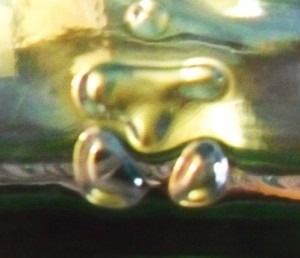
“Three triangle-shaped bumps” — Vitro “stylized V” or “Check mark” trademark as seen on 2008 Commemorative Coke Bottle - V (stylized “V” trademark, as shown)………………Vitro (Vitro Packaging), Monterrey, Mexico, now [2022] known as Vitro Glass Containers, with a manufacturing plant at Toluca, Mexico – but production at the Toluca plant is primarily liquor, pharmaceutical and perfume bottles. Vitro originated in 1909 under the name Vidriera Monterrey, of Monterrey, Nueva Leon, Mexico. The first use of the business name “Vitro” was in about 1979. Vitro opened a distribution plant within the US in 1985. In July of 2015, Vitro (as far as their food and beverage container division) was acquired by Owens-Illinois (O-I) so I believe this V mark has since been replaced by the “O-I” mark as used by Owens-Illinois on food and beverage bottles and jars. This info would generally date the “V” mark seen on food & beverage bottles to the time period of about 1985-2015. This mark is seen on many glass containers imported into the US, especially soda and beer bottles and food containers such as for salsa, spaghetti sauce, jam, etc. On some containers the mark may be very indistinct, and usually appears as merely a group of three triangularly-shaped raised dots or bumps. The mark is often on the heel of the container.
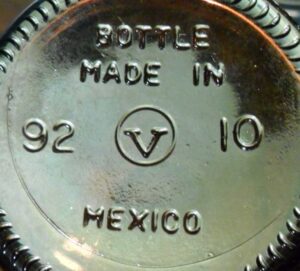
“V in a circle” mark on base of Sioux City brand Wildberry soda bottle. - V in a circle (on bottles)………………… Vidriera Oriental, Mexico City, Mexico (1980 – 1999). More info on Mexican glass marks at this article: https://sha.org/bottle/pdffiles/MexicanMarks.pdf Photo shows the base of a “Sioux City” brand soda bottle, and the “92” is a date code for the year 1992. Please see next two entries.
- V in a circle (seen on colored reproduction pattern glass tableware and novelty glass, NOT utilitarian commercial containers)……………. Summit Art Glass Company, Akron, OH and later Ravenna, Ohio (1972-2006). The “V” in this case stands for Russell and Joanne Vogelsong, owners of the company. Much of the glassware in earlier years were actually made by other glass companies, using molds owned by the Vogelsongs. In 1984 they opened their own glass factory in Ravenna. Only a percentage of glass they sold carries the “V in a circle” mark. Here are two sites with a bit more info: http://www.carnivalglassclubs.com/Summit.html and https://www.realorrepro.com/article/V-in-circle-mark-
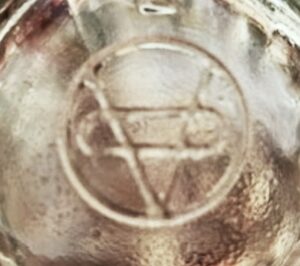
V and horizontal oval within circle (Photo courtesy of Anselmo Abdo). - V entwined with a thin horizontal oval, placed inside a circle………… currently unidentified. This mark appears on the base of a clear Coca Cola bottle found along the north coast of Cuba. Presumably this mark was used by an unidentified glass manufacturer located in Mexico or, perhaps, in one of the countries in Central or South America. If anyone recognizes this mark, please contact me and I will add the information to this entry.
- V inside a circle………..Vidroporto S.A., Sao Paulo, Brazil (1981-to date). This mark is listed in the Emhart database of worldwide glass manufacturers’ punt marks, but I don’t know when this “V inside a circle” was first used by Vidroporto. There is apparently no connection with the first “V in a circle” mark (used by Vidriera Oriental) from Mexico as shown above.
ADVERTISEMENT
- V in a diamond……………… Diamond Glass Vienna Inc., Vienna, West Virginia (1981- c.1986) . Confirmed on the base of a clear liquor flask with a 1981 date code. This firm was one of the subsidiaries of Diamond-Bathurst, the other glass container subsidiary (in the US) being Diamond Glass Company of Royersford, Pennsylvania.
- V in a keystone………………….unidentified meaning. This has been reported to me several times, but I have no information on what it stands for. Please see the comment posted by William Latimer on the “Glass Bottle Marks – Page 3” page (comments section) from January 1, 2017, along with my reply to him. So far, it’s been seen on a clear flat flask marked “WINE BOTTLE”; on the base shard of a cylindrical wine bottle (Thank you Carol Serr!); a gallon size bottle/jug marked A-9; and a clear glass rectangular bottle that probably held some brand of men’s hair oil or hair tonic. That bottle is also marked with PAT.934 (and possibly other numbers) on the base. I think there is a chance the letter was actually intended to be a “U” but I could be mistaken.
- V inside a square (see “U inside a square” on this page).
- Vaseline………………………..please see Chesebrough Mnfg Co webpage here.
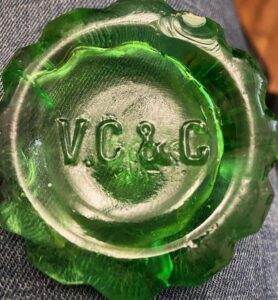
“V. C. & C.” on base of green bottle. (Photo courtesy of Miles Burke). - V. C. & C. (shown above) …………………………….. unidentified meaning. This mark has been recorded on several styles of emerald green bottles from Europe – presumably made in Great Britain. They are food bottles, and likely date from the 1880s-1900s time period.
- V.D.CO…………….. Unknown. Possibly Alfred Vogeler Drug Company?
- VE (letters connected, shown above) ……………………….. Vetreria Etrusca, business offices in Montelupo Fiorentino, near Florence, Italy (glass manufacturing plant located in Altare, Savona, Italy). (1920-to date). I don’t have solid information concerning what year this company started using their VE-connected logo, or what other marks (if any) may have been used in previous years. Most of the containers bearing this mark seem to be relatively recent production, probably from the 1970s-1980s and thereafter. Many types of items have been made including olive oil and vinegar cruets, kitchen canisters, square candle holders, “fish” bottles, and other kinds of decorative and household bottles. Many items are found in a characteristic very light greenish-aqua colored glass similar to the older Coke bottles. If you have information on exactly when this mark was introduced, and what (if any) other marks were previously used by this glassmaker, please let us know!
- VF (what appears to be “vf” connected, in lower case letters, as seen on the bases of ten-sided glass jars containing Bonne Manan brand preserves, shown below). This mark is used by Verallia France (formerly Saint Gobain); see the post below (in the Comments section) submitted by “Wowter” on July 14, 2021. The URL here points to a webpage on a French-language blog, where that mark is shown on the heel of a clear glass bottle made by Verallia France). https://www.boboco.fr/blog/article/comment-un-constitue-un-pot-.html
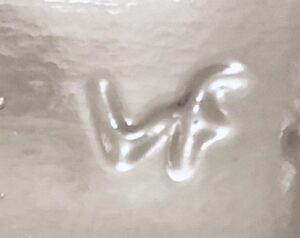
“vf” glass manufacturer’s mark on base of ten-sided glass jar containing BONNE MAMAN brand fruit preserves. This mark stands for Verallia France.
- V.G.CO. or V superimposed over a G ………………………..Victory Glass Company, Jeannette, Pennsylvania (c. 1919-1955). Specialized in making clear glass candy containers in the shapes of various objects including telephones, animals, airplanes, etc. (Info from Glasshouses & Glass Manufacturers of the Pittsburgh Region 1795-1910 by Jay W. Hawkins, 2009). The V/G entwined mark is seen on the base of clear/amethyst tint jars (similar to fruit jars) made for an egg beater / hand mixer assembly patented March 30, 1915, patent #1,133,413. The letter “G” looks vaguely like a sideways Greek ‘Omega’.
- VI (inside horizontal rectangle or square)…………. Verallia (Saint Gobain). This mark is seen on Saint Gobain bottles produced at several glass plants located within the country of Italy (as of 2013). Most Verallia/Saint Gobain bottles made in the United States carried an “S G” mark, until 2014 when Ardagh Group bought those plants. After 2014, they may carry the “horseshoe” or “upside-down Omega sign” used by Ardagh. See that logo under the “U” listings. Also, please see Saint Gobain page.
- Vicks VapoRub…………………see this webpage about the cobalt blue Vicks Vaporub jars and the four base types seen, including the “Double Triangle” here: Vicks Vaporub Jars .
- VICTOR (on base of clear glass medicine bottles)……… trademark for line of pharmaceutical bottles, used by Obear-Nester Glass Company, East St. Louis, Illinois, circa 1902-1920 (History of Drug Containers & their Labels, Griffenhagen & Bogard, 1999, page 129).
- V and M, entwined, placed inside a circle……………..Vidriera Monterrey, Monterrey, Mexico (1909-to date). See “M and V entwined inside circle” entry on page four.
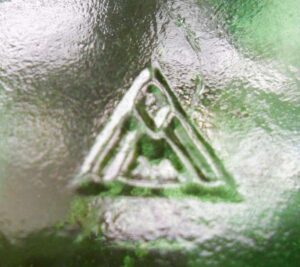
- V above M, inside a triangle, monogram as shown. Viewed upside down, mark looks somewhat like a W inside a triangle) …………………..Vidriera Monterrey, Monterrey, Mexico (1909-to date). Exact period of use of this mark uncertain. I have two green wine bottles (a type formerly encased in wickerwork), date-coded 1956 and 1958, both bearing this mark. Vidriera Monterrey is a glass container factory “ancestor” to the present corporation Vitro Packaging. (See “V” mark, also see the “M above V in a circle” mark).
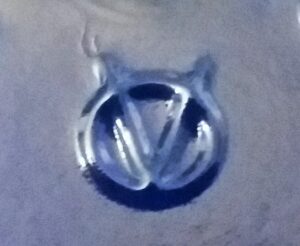
V and O entwined – on base of cobalt blue “Acqua della Madonna” water bottle made by Vetri Speciali, formerly known as Vetrerie Venete S.p.A. This mark is used at their factory location at Ormelle, Treviso, Veneto, Italy. - VO (V entwined/superimposed over an O) ………………………….. as seen on the base of some Italian-origin containers imported into the United States, such as bottles containing Lucini brand olive oil and Acqua della Madonna spring water………………… Vetri Speciali, formerly known as Vetrerie Venete S.p.A., this mark used at their factory location at Ormelle, Treviso, Veneto, Italy.
- Votive candle holders……………..see this page: Hobnail type votive candle holders that discusses the common “Hobnail” pattern candle holders (vigil tumblers or candle cups).
- vP (see logo illustrated here). This mark, presumably a monogram composed of V and P joined together, was shown in Julian Toulouse’s Bottle Makers and their Marks (1971) on page 582. He stated that the mark was in use by Weck Glassworks (Germany) in 1969. He also wrote that the mark was used by Von Poncet Glashüttenwerke GmbH, Oflingen, Germany, in 1965. The same mark is seen on a recent packer jar that contained fruit preserves, for sale on store shelves in the US in early 2024 (the jar was probably made in 2023). More info is invited on the current name of this glass manufacturer!
- VR-connected (The letters “V” and “R” are combined with one vertical stroke forming both the right side of the V and the left side of the R). Possibly Vidreiera Los Reyes, glass container (“envase”) manufacturer in Mexico (1944- ?). Bottles and jars with this mark MIGHT date from the 1970s-1990s era? If you have more accurate information on this trademark, please advise!

V T Co monogram – Victorian Trading Company, seen on base of candle holder (photo courtesy of Ann Schwoerer). - VTCo (V T Co) (monogram, shown here)………………….. Victorian Trading Company, Lenexa, KS. This seems to be a distributor of upscale nostalgic decor products sold via catalog and online. The mark is seen here on the base of a clear (with cranberry colored stain) “Eyewinkler” pattern candle holder, of uncertain date, probably made in the 2000-2022 time period. The company was later known as “The Queen’s Trading Company” and now [2024] reorganized as “Hopeless Romantic Trading Co.”. The glass is presumably made by unnamed manufacturers in the US or Asia.
- VVV (letters connected, inside circle, with two horizontal lines placed above and below the letters)………….. please see this webpage on Vicks Vaporub jars. This is one of the four base variations seen on cobalt blue Vicks Vaporub jars.
- 5 W …………………….. Winslow Glass Company, Matthews, Indiana (1900-1908) and Columbus, Ohio (1902-1927). The “5W” mark was actually began in 1912 (fulfilling government requirements for a glassmaker mark to appear on all milk bottles), according to Julian Toulouse (Bottle Makers & Their Marks, 1971, page 532), and is seen on milk bottles only. Berney-Bond Glass Company purchased the plant in 1927, and eventually Owens-Illinois acquired the plant in about 1931 which became their factory #18.
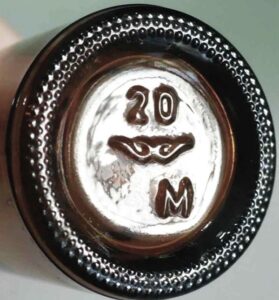
“W” on the base of miniature sampler whiskey bottle made by Wisthoff & Company Glashutten, Essen, Germany. (Photo courtesy of Laura Frankovic-Brown) - W (somewhat flattened “W” trademark, seen on the base of miniature sampler liquor bottle in amber, shown above)………………… Wisthoff & Co. Glashütten, Essen, Germany. A drawing of this mark is shown in Bottle Makers and their Marks (Toulouse, 1971) on page 583. At a quick glance it might resemble a simplified bird with wings outstretched during flight. Please see photo of the mark here. (The “20” is a mold number, and the “M” is a mold mark of uncertain meaning – the M does not stand for a glass company – as is the case with certain bottles made by other companies such as Maryland Glass Corp.). According to Toulouse, Wisthoff was using this mark in 1965. The mini sampler bottle shown (sometimes called a “nip” or “airplane bottle”) is of uncertain date, possibly from the 1960s-1980s. Wisthoff is now (2023) part of the huge corporation Gerresheimer Glas. The glass container factory at Essen is shown as “Gerresheimer Essen GmbH” on their website. Not sure when this mark was discontinued (assuming it is no longer in use). If someone knows, please contact me!
- W……………………… on handmade antique bottles made in the United States, uncertain – this could stand for any of several firms, possibly Wormser Glass Company, Pittsburgh, PA (c. 1875-c.1927) or Thomas Wightman & Company, Pittsburgh, Pennsylvania (1872-1893), later Thos. Wightman Glass Company (1893-1917) / Wightman Bottle & Glass Company (1917-1921). There is also a possibility that some bottles marked with just a “W” on the bottom are products of Whitney Glass Works, Glassboro, NJ (c. 1875-1918), but that is only a guess! A square, handmade applied-lip aqua pickle bottle that bears a “W” on the base looks to date from the 1880s or 1890s. Fruit jars with “W” on the side, and and “L &” faintly visible (removed from the mold) are believed to be Thomas Wightman & Co. products. A detailed timeline of that company and its various incarnations can be found in Jay W. Hawkins’ Glasshouses and Glass Manufacturers of Pittsburgh Region 1795-1910 (2009).
- W (on the bases of modern clear and amber glass serum or “vaccine” bottles)……………….. Wheaton / Wheaton Industries, now part of DWK Life Sciences (since 2017). Often the “W” will be accompanied by a number, such as “W-1”. See “W in a circle” and “Wheaton”.
- W (with a line underneath, inside a circle)…………………….L. G. Wright Glass Company, New Martinsville, West Virginia (1937-1999). This mark is a recent one and I don’t know the exact date range, but am guessing it was used by Wright in the 1980s and 1990s. Wright specialized in producing “upscale” tableware and glass novelties, usually of patterns originally popular in the late 1800s and early 1900s. Glass in a wide variety of colors was produced. Wright did not actually make the glass themselves, but had other glass companies pour it for them (such as Fenton, Westmoreland, Summit, Mosser, Viking, Fostoria, Plum and others), using molds owned by Wright. Wright then sold/distributed the ware under their own company name. This mark, for instance, appears on the inside bottom (not embossed on the outside of the base, as would be more typical) of a ruby red “Double Wedding Ring” pattern toothpick holder. It is likely that some molds with this mark are being used to produce glassware by other, more recent company(s), since Wright sold off their inventory of glass molds in 1999; they were auctioned off to a number of other entities. Also, please see next entry.
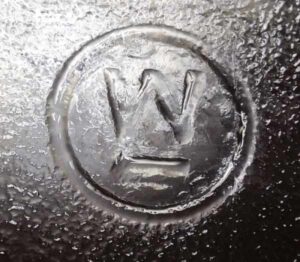
Underlined W inside circle trademark used by Westinghouse Electric Company – on base of glass refrigerator dish or loaf pan - W (with a line underneath, inside a circle)…………..on glass refrigerator dishes or loaf pans, Westinghouse Electric Company. Made to be used with refrigerators sold by Westinghouse. These probably date mostly from the 1930-1950s. They might have been made by Corning or some other glass company for Westinghouse. This underlined-W mark is also seen on Westinghouse porcelain electrical insulators. These glass items with the Westinghouse “W” have no connection with L. G. Wright Glass Co. (see entry above) that made upscale novelty and decorative glassware.
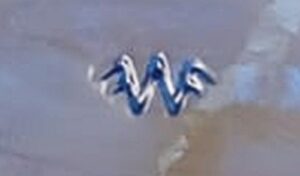
FWF (Winged W) mark used by Wilkerson Glass after 1989. (Photo courtesy of Joe Stiles) - W (actually FWF, sometimes called “Winged W” or “Flying W”)………………… Wilkerson Glass, Moundsville, West Virginia (1975 to present). This mark was used after 1989 when Fred Wilkerson, Jr. joined his father in the business. See entry under FWF on page three.
- W & CO………….Thomas Wightman & Company, Pittsburgh, PA (c.1874-1895+). See “T.W.& Co.” and “L&W” marks.
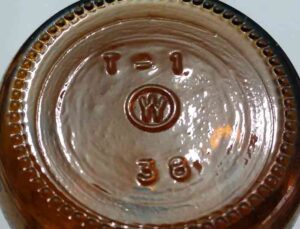
- W in a circle (above) ………………. T. C. Wheaton Company, later, Wheaton Glass Company, and later, Wheaton Industries, based in Millville, New Jersey (1888-to date). Now known as DWK Life Sciences (since 2017). This mark is seen on the bottoms of many laboratory, chemical & drug bottles including very small vials, and has been in use since 1946. (Uncertain on the last year this particular mark was used.) In recent decades, Wheaton has expanded with a large line of products catering to the medical / pharmaceutical / scientific world. As far as glass bottle production, the company produced large quantities of colorful commemorative and decorative bottles, especially in the 1960s, ’70s and ’80s. (See “Wheaton” entry on this page). They manufacture a good percentage of the small “serum bottles” or “vaccine bottles” and sterile injection vials (the small vials used to contain vaccines, etc.) sold in the United States and other countries. Update: Wheaton has gone through a confusing series of reorganizations/mergers and company takeovers within the last few years. As of 2015 Wheaton came under the control of DURAN Group GmbH, later (2017) renamed DWK Life Sciences, of Germany. For a good overview and general outline on Wheaton and its history (primarily up into the 1990s), check out this article: https://www.encyclopedia.com/books/politics-and-business-magazines/wheaton-industries Also, please see “T. C. W. Co.”, “Wheaton” and the other “W in a circle” entries on this page!
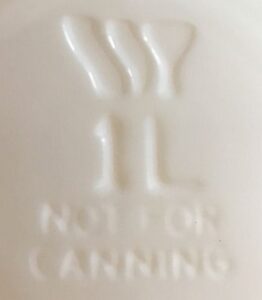
Stylized “W” mark, used by Wheaton Fine Glassware, circa 1980-1984. (Photo courtesy of Marianne Lower). - W (stylized representation of letter “W” consisting of three vertical “segments”, the one on the right resembling a wineglass or goblet), often accompanied by the notation “Not for Canning” , as seen on the base of milk glass canister sets and other items ………….. Wheaton Fine Glassware, division / brand of Wheaton Industries (mark presumably used c. 1980-1984, according to information presented in article linked below). This particular jar or canister is also marked “1 L” indicating the capacity of the container is one liter. (See “Wheaton”, “T. C. W. Co” and “W in a circle” entries). https://www.encyclopedia.com/books/politics-and-business-magazines/wheaton-industries
- W inside a circle (as seen on bases of emerald green Jägermeister liqueur bottles made in Germany)………………… container manufacturer Wiegand Glas, with factory locations at Steinbach am Wald (Bavaria); Großbreitenbach, Ernstthal, and Schleusingen (those three in Thuringia), Germany. The company name was listed as “Bayerische Flaschen-Glashüttenwerke Wiegan & Sohne GmbH” in Toulouse’s Bottle Makers and their Marks (1971, page 579).
- W inside a circle…………….. In some cases, the “M inside a circle” mark used by Mosser Glass Company, Cambridge, OH, appears (when viewed upside down) to be a W inside a circle because of slightly diagonal strokes of the two “legs” of the letter. This appears mostly on upscale novelty glassware and reproduction decorative/ ornamental ware, not utilitarian bottles. Please check the M entries concerning Mosser near the top of this page, showing a pic of this mark.
ADVERTISEMENT
- W in a diamond ………………….Whitney Glass Works, Glassboro, New Jersey (c. 1875-1918). This particular mark confirmed on the bottom of clear, handmade “generic” druggist/pharmacy bottles which probably date from sometime in the 1885-1910 period. The mark is also occasionally seen on personalized “slug plate” druggist bottles, an example being one marked “W. A. FISCHBECK / PEOPLE’S DRUG STORE / BLOOMINGTON, ILL.” on the front. (Please see next entry, and also “Whitney Glass Works” on this page).
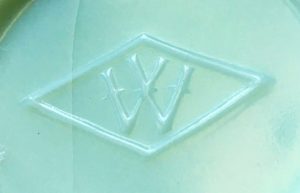
“W in a diamond” used by Westite Glass Company, as it appears on the base of a jade green milkglass vase (Photo courtesy of Abby Chovanec) - W in a diamond (shown)……………. Westite Glass Company, Weston, West Virginia (1930-1936). Maker of unusually-colored slag glass novelties such as planters, vases, ashtrays, etc, similar to the appearance of Akro-Agate glassware. The “W” could be seen as two overlapping capital letter ‘V’s, which would separate it from the appearance of the mark used by Whitney, above.
- W in a keystone…………………Westmoreland Glass Company, Grapeville, Pennsylvania (1889-1984). This mark was used from 1910 to 1929. See “W superimposed over a G” entry.
- W inside a “house” or “building” outline / emblem………………… Nienburger Glas GmbH, Nieburg, Germany. See “House” entry on page three for a photo of this mark.
- W in a rectangle or square………….Wood’s Bottle Works, Portobello, Scotland, United Kingdom (this particular mark used circa 1900-1920, according to Julian Toulouse, Bottle Makers and their Marks, 1971). W in a rectangle is confirmed on the base of a “Brand & Co. Ltd, Mayfair, The ‘A-1’ Sauce, London” bottle, reported to me by Don via email. Thanks Don!
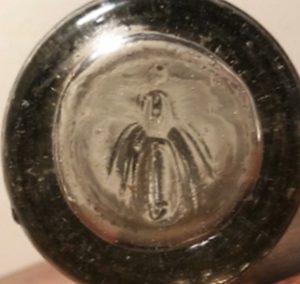
Wasp mark on base of Booth Bros , Philadelphia, hutch soda (Photo courtesy of Raymond Buch) - Wasp (insect) logo (shown at right) …………………….. unknown meaning, but probably that of an unidentified glass bottle manufacturer. This image is seen on the base of some “hutch” style soda bottles, probably dating from the late 1890s or very early 1900s. In particular, appears on the bottom of a Booth Bros, Philadelphia bottle, as reported by Ray Buch.
- Water drops/teardrops/droplets (Logo/emblem representing two drops of water)……………… Paşabahçe, Turkey. See “Drops/Droplets” entry on page two.
- Waterford……………… Waterford Crystal, Waterford, Ireland (1783-1853 and 1947-to the present) …………….. The original Waterford factory opened in 1783, founded by entrepreneurs William and George Penrose. The glassworks specialized in producing extremely high quality handmade blown and cut crystal (leaded glass) including wine glasses, goblets, tumblers, bowls, decanters and other items. The company gained a reputation for extremely well-made, intricately cut glassware. The company continued for about 70 years until it closed down after undergoing financial problems in 1853. Then, for nearly one hundred years no glass was produced, but the Waterford name was resurrected in 1947 when two Czech immigrants (Kael Bacik and Miroslav Havel) started a new operation at Waterford. They strived to create new handmade glass with the look and quality of the original Waterford cut glassware from the 17th and 18th centuries. The “new” Waterford Crystal glassworks is still operating as of 2024. Most of the crystal made by Waterford before the 1980s was not permanently marked. Marking commenced sometime in the 1980s and the WATERFORD name appears (often rather hard to see) etched underneath on the base. However, some of the newer Waterford is also not marked. Most of the more recent production carries a sticker and/or permanent mark incorporating a seahorse motif. “Waterford” is considered (by some) almost as a “generic” name for very high quality cut crystal. An excellent article about Waterford Crystal from the antiquesarena site can be found at this URL: The Ultimate Guide to Waterford Crystal: History, Value, Identification and More
- Watkins (J. R. Watkins Co.)……………….see J. R. Watkins Co. page.
- Wave (gently curved horizonal lines) design, inside a diamond………………… see entry in the “Unidentified” marks at bottom of the listings on this page.
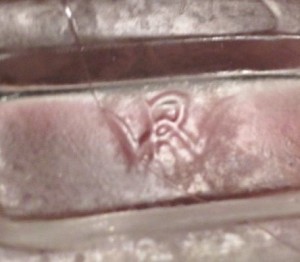
- W superimposed over B (or could be B superimposed over W)……………..Uncertain. This mark (shown above) seen on base of handblown, tooled-lip clear or sun-colored amethyst prescription bottles (probably dating c. 1900-1915), found in Hawaii. Possibly used by Western Bottle Manufacturing Company, Chicago, but no proof of this.
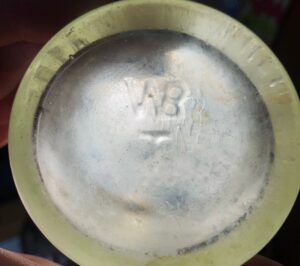
WB-connected mark on base of Cassidy & Co., Rochester, N.Y. champagne-style blob beer bottle. (Photo courtesy of Miles Burke). - WB connected (WB ligature) on bases of beer bottles…………………….. Wittemann Bros, New York City, NY (c. 1885-c.1920), later at Buffalo, NY (c. 1920-c. 1928). Wittemann Bros. was a wholesaler/distributor of supplies for the beer and soda bottling industry, and also sold other products such as postcards. They were not a glass manufacturer, so would have had contracts with bottle makers to supply bottles marked with their initials. The glass manufacturer(s) of the WB-monogram bottles is unidentified, but likely a firm in the NY/NJ area. More info on Wittemann can be found here: https://sha.org/bottle/pdffiles/WOther.pdf
- W. B. Caldwell’s……………please see “Dr. W. B. Caldwell’s” webpage.
- W.B.M.CO………………Western Bottle Manufacturing Company, Chicago, Illinois (1901- c. 1931). Maker/distributor of druggist bottles and other drug/health related items including toothbrushes, nursing bottles, etc. May have been a bottle jobber (not actual manufacturer) in later years? Some published sources on the web indicate they did business as “The Western Company”, at least for some period of time. More info requested! Possible user of the mark “W superimposed over B” listed above, which is found on the base of druggist/prescription bottles.
- W. BROOKFIELD (seen on glass electrical insulators) ……………marking used by Brookfield Glass Company at their first glass plant located in Brooklyn, New York. The “W” in this case actually stands for “William”, although the letter is often misinterpreted as meaning “West”. Most insulators that bear this marking were made in the late 1860s up to around 1905. Their later insulators were marked with BROOKFIELD with the letter “W” having been removed. For more info on this glassmaker, please see my webpage on Brookfield Glass Company (Bushwick Glass Works).
- W & C…………..Unknown
- W.C.D………………W.C.DePauw Glass Works (fruit jar/window glass division of the DePauw’s American Plate Glass Works), New Albany, Indiana (1879-c.1893). Initials are embossed in a semi-circle on the base of “MASON’S PATENT NOV 30th 1858 ” type fruit jars, along with a mold number such as “44”. This factory was known as Star Glass Works (or Star Glass Company) from c.1869 to about 1879, although the former name continued to be used casually for years after the “official” title of the works was changed. See “Star” mark, and Star Glass Company webpage.
- W.C.G.CO. ……………………. West Coast Glass Company, Los Angeles, California (1918-1930). According to Julian Toulouse (Bottle Makers & Their Marks, 1971, page 536) this company primarily made milk bottles, some being found with this mark on the bottom. (Jelly glasses and tumblers were made before 1921). Toulouse doesn’t mention any other types of bottles that were made. Presumably most of the milk bottles made by West Coast were distributed in CA and the western states of the U.S. However, a tooled-lip, handmade (mouthblown) rectangular prescription bottle in clear glass (with slight grayish tint) marked “3 OUNCES” on the front was found in the east (Virginia) that bears this mark on the base. (Although the “o” is lower case). Another type of generic druggist bottle of the same basic shape and with the same marking was dug in the Rome, NY area. If another bottle manufacturing company used these initials, which certainly appears likely, it was probably located somewhere in the Eastern part of the United States. One possibility would be a short-lived venture, the Wightman Co-operative Glass Company, Port Allegany, Pennsylvania (1915-1917). At this time, I consider the initials on those prescription bottles to be that of a glassmaker that has not been identified with absolute certainty, but Wightman sounds like it would be a likely candidate. For more info on West Coast Glass Company, see this article from Pete Schulz, Bill Lockhart and the Bottle Research Group: https://sha.org/bottle/pdffiles/WestCoastGlass.pdf
- W.D.CO……………..see next entry.
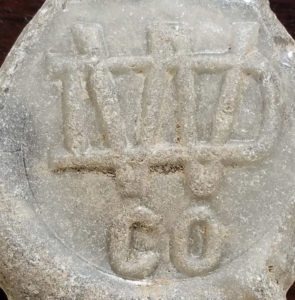
- W D CO (monogram, shown)…………….this monogram (and the above mark) apparently stands for the West Disinfecting Company, New York, NY (E. Taussig & Co., Proprietors), circa 1890s. Thanks to Jim Novak for info. For more information, see this page: https://baybottles.com/2018/07/17/cn-disinfectant-west-disinfecting-company-new-york/
- W.D.& G………………Unknown, seen on the bottom of an amber strap-side flask, perhaps circa 1885-1915 (shown below right).
- WEBER…………………..O. J. Weber Company, Los Angeles, California. Mark seen on bases of a number of milk bottles from California. The O.J. Weber Co. was a supply house for dairy equipment, in business by 1906 and continuing until 1936 or somewhat later. They apparently contracted with more than one glasshouse over the years to have milk bottles made with their name embossed on the bottles. (Information from Bill Lockhart & Carol Serr).
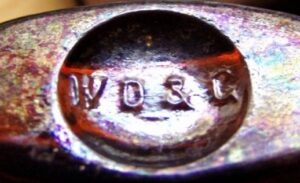
- Weeks & Gilson, So. Stoddard, N. H. ………………….Weeks & Gilson, South Stoddard Glass Manufacturing Company (c. 1851-1873). This marking appears embossed in a circle on the base of cylindrical whiskey/wine bottles, usually in dark shades of amber or green. A nice article with illustrations of various bottles and shards, some of which were found at the South Stoddard site can be found on pages 52-55 of the August, 1933 issue of Magazine Antiques, written by Lura Woodside Watkins. Also, a recent article on Stoddard history, written by Michael George, can be found at the http://www.peachridgeglass.com site .
- Weeks Glass Works…………… lettering arranged in a circular formation, as seen on the bases of a few cylinder whiskey bottles, this mark was evidently used on some bottles produced by Weeks & Gilson, South Stoddard Glass Manufacturing Company (above). The bottles with this marking presumably date from sometime between 1851 and 1873.
- W.E.MFG.CO. (embossed lettering on the dome of CD 126.4 style glass pintype telegraph insulators)……………….Western Electric Manufacturing Company, based in Chicago, IL, in business beginning c. 1869. This insulator type was made by Hemingray Glass Company for an unknown length of time beginning in about 1872. https://www.hemingray.info/database/detail.php?id=126.4
- Westford Glass Co…………Westford Glass Company, Westford, Connecticut (1857-1869). Embossed wording seen on several figural / pictorial whiskey flasks, including the “Sheaf of Grain” flasks, GXIII-36 and GXIII-37 variants.
- W. F. M. ……………..Aetna Glass Works (William F. Modes, Proprietor), Pittsburgh, Pennsylvania (c. 1867-c. 1869). The Aetna Glass Works was also known, for a time, as “Arsenal Glass Works”. Mark seen on the base of certain “Mason’s Patent Nov 30 1858” fruit jars. William Modes was also involved in several other, later glass companies, including Beaver Falls Glass Company, Beaver Falls, Pennsylvania, and Modes Glass Company of Cicero, Indiana (see M. G. Co. page).
- W.F.& S…………On certain bottles dating from the 1870s, William Frank & Sons, Pittsburgh, Pennsylvania (1866-1876). In most cases, a similar mark (usually seen with “MIL” or “MILW” as part of the embossing) indicates the bottle was made by an unrelated concern, William Franzen & Sons, of Milwaukee, WI.
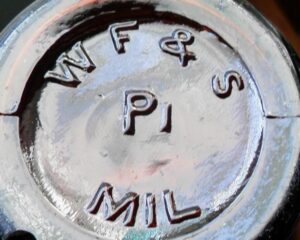
William Franzen & Sons- W F & S MIL marking on base of amber beer bottle. - W.F.& S. MIL (shown, right) ……. See next entry.
- W.F.& S. MILW……………… William Franzen & Sons Company, Milwaukee, Wisconsin (1893-1920). This and the mark listed above are commonly seen on many beer bottles from breweries located throughout the U.S. Midwest. For more info and pics of a few bottles, see this page: http://www.mrbottles.com/Category/WilliamFranzenSonsCo
- W.F.& Sons………..William Frank & Sons, Pittsburgh, Pennsylvania (1866-1876). Earlier known as Wm. Frank & Company (1846-1866), although actual glass manufacturing didn’t begin until 1858 as during the period 1846 to 1858 the firm was only a dry goods/mercantile establishment. After 1858, when the glasshouse was built, it was also called the “Frankstown Glass Works”.
- WG, W/G ………………………………….see next entry.
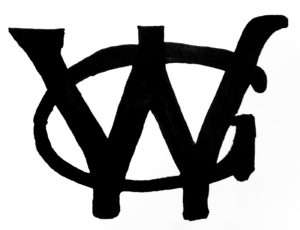
Westmoreland Glass Company – “W superimposed over a G” – mark used c. 1949-1984. - W superimposed over a G………….Westmoreland Glass Company, Grapeville, Pennsylvania (1889-1984). To be more accurate, this glass maker was known as Westmoreland Specialty Company from 1889 to 1924, being officially renamed in 1924 or early in 1925. The “W over G” monogram is seen most commonly on high-quality colored and opaque pressed and pattern glass, including tableware, novelties, hen-on-nest covered dishes, etc. Westmoreland Glass produced huge quantities of white milk glass tableware during the 1940s and 1950s, much of it avidly collected today. A lot of their earlier ware was not marked. This particular mark reportedly dates from 1949 to 1984. (See also “W in a keystone”, an earlier mark used by Westmoreland). Caution: This mark is also seen on some more recent items, such as hen-on-nest dishes, that were made after 1984 but produced from older molds which have since been sold to other glass making companies. For more information on Westmoreland, try visiting this page on the Westmoreland Glass Club site (indexed into the Wayback Machine web archive database) here: Westmoreland Glass Club – Brief history of Westmoreland Glass Company
- W. G. B. Co. / DEPTFORD (lettering arranged in a circular formation, as seen on base of black glass utility bottle, probably for ale) ………………Wear Glass Bottle Company, Deptford, Sunderland, Durham, United Kingdom (c. 1820s-c. 1890). A bottle with this mark appears to date from the late 1850s or 1860s. Catherine Ross, in “The Development of the Glass Industry on the Rivers Tyne and Wear – 1700-1900” (thesis, 1982, page 260), writes that a bottle works in Deptford (which was in existence by 1816 and probably before) was known as the Wear Glass Bottle Company by the 1820s. The firm was also known simply as the “Deptford Bottle Works” for some time during its operation.
- W.G.CO……………..Used by at least 2 or 3 companies (or more). Wisconsin Glass Company, Milwaukee, Wisconsin (1881-1886) produced beer bottles with these initials on the base. Those beer bottles are usually found in some shade of amber glass. A “W G CO” mark is also confirmed on a clear, rectangular mouth-blown druggist bottle, circa 1900. A possibility for the source of the mark in that particular case might be the Wagner Glass Company, Ingalls, Indiana (1895-1908). Company info on Wagner can be found in Dick Roller’s Indiana Glass Factories Notes, page 49. Julian Toulouse states (Thos.) Wightman Glass Company, Parkers Landing, Pennsylvania (he wrote “1900-1930”, but more recent info indicates c. 1893-c. 1921) as the user of “W.G.CO.” (See “W”). I also suspect that some bottles made by Wormser Glass Company, Pittsburgh, might have carried this mark. Woodbury Glass Company (1893-1920) with three plants located in Indiana (at Parker, Winchester and Shirley) made some machine-made milk bottles with “W.G.CO” on them, typically on the heel, according to research by Bill Lockhart. Note: In the case of Wisconsin Glass Company, the embossing “MILW” is usually included, but some bottles do exhibit the lone “W.G.CO.” marking. See next entry, as well as “WIS.G.CO.” and related marks.
- W.G.CO. MILW…………….Wisconsin Glass Company, Milwaukee, Wisconsin (1881-1886). Noted on blob-top beer bottles. Also, see “WIS. G. CO.”
- W. G. & Co. ………………………(recorded as seen on base of wax sealer fruit jar, in The Fruit Jar Works, Volume 1, Alice Creswick, page 220). Unknown, possibly a mold engraver error for “W G. Co.”
- W.G.M.CO……………Western Glass Manufacturing Company, Valverde, Colorado (1900-1909). Glass insulators are known with these initials on the “skirt”. Many of those insulators are found in several shades of amethyst/purple. A number of bottles, usually beer or liquor bottles, were also made bearing these initials on the base. WGMCo also used what is termed a “belt buckle” logo, as well as a variety of numerical code marks on their bottles, and this article by Bill Lockhart has more details on those marks: https://sha.org/bottle/pdffiles/WesternGlass.pdf
- W.G.W (monogram)………..Woodbury Glass Works, Woodbury, New Jersey (1882-1900)
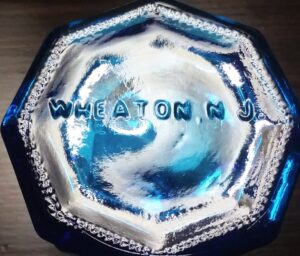
“WHEATON NJ” on base of sapphire blue decorative, octagonal ink bottle marked “CARTER”. - Wheaton (or Wheaton NJ) ………………………Wheaton Glass Company / Wheaton Industries, Millville, New Jersey (1888- to present). (Now known under DWK Life Sciences – since 2017). Producer of many reproduction bottles, Avon cosmetic, cologne, decorator bottles and a wide variety of other glassware. See “W” (stylized), “W in a circle” and “T.C.W. Co.”. entries. The Wheaton enterprises have had a rather complex history since 1888. After several restructurings, buyouts and renamings, Wheaton Industries (DWK Life Sciences) has diversified and is primarily a manufacturer of many lines of pharmaceutical/scientific products, including their “old standbys”- glass serum bottles, used to contain vaccines and other pharmaceutical products. Many if not most of the reproduction bottles, “fantasy” bottles, decorative figural flasks and containers marked “WHEATON” or “WHEATON NJ” on the bottom were made during the 1960s – 1980s. The “Cape Cod” ruby red glass line of tableware produced for Avon was manufactured over a period of many years: 1975-1993. (See the page on Avon bottles for a picture of these Cape Cod style goblets). Some items are marked “Nuline”, and many of the repro/fantasy bottles have an “imitation” pontil mark on the bottom, which looks like a depressed area in the glass, sometimes vaguely shaped like the outline of a state such as Iowa or Ohio! Some items such as canister sets are marked with a “stylized W” (see entry above on this page) and those were issued under the name “Wheaton Fine Glassware” in the 1980-1984 period. For some more background information on Wheaton, please see this article: https://www.encyclopedia.com/books/politics-and-business-magazines/wheaton-industries
- Wheaton Fine Glassware (see entries on “Wheaton”, “W” stylized letter).
- Whitney Glass Works……………..Whitney Glass Works, Glassboro, New Jersey (c. 1836-1918). Claiming an “ancestry” dating back to the late 1770s, as early as 1836 this firm operated under the name “Whitney Brothers”, although in later years (by 1875, if not before) it was known as “Whitney Glass Works”. The “official” name of the firm became “Whitney Glass Works” in 1887 (according to Adeline Pepper, The Glass Gaffers of New Jersey – 1971, page 42), although ads dating from 1875 show both versions of the factory name within the same ad. This glass works made many types of bottles, including the famous original “BOOZ” bottles shaped like a cabin, the Drake bitters bottles, and many others. Various bottles are marked “WHITNEY GLASS WORKS” in a circle on the base, and these may date after 1887, although I feel that some might date before that year, since the timeline as to when the name was first actually embossed on their bottles seems rather “fuzzy”. In 1918 this factory became a part of the Owens Bottle Company. In 1929, after the forming of Owens-Illinois Glass Co, the plant became O-I plant #8.
- Whittemore / Boston / U.S.A or Whittemore / Boston // French / Gloss …………… for more information, please see my page on Whittemore.
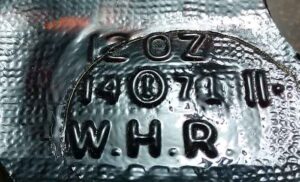
‘W. H. R.” marking on amber bottle base shard. This is probably the base from a MAALOX bottle. Maalox was an antacid marketed by the William H. Rorer pharmaceutical company. The “14” indicates the Owens-Illinois plant at Bridgeton, NJ. The “71” is a date code for 1971. - W.H.R. ……………………William H. Rorer, Inc., based in Fort Washington, Pennsylvania, pharmaceutical company that produced a number of drugs, including their most well known products, Maalox and Quaalude. Those initials are seen embossed on the bases of some of their rectangular medicine bottles in amber and clear glass. These were probably containers for such drugs as Maalox and Camalox, possibly others. The bottle bases I’ve seen bear date codes in the 1960s and 1970s and were made by Owens-Illinois (“I inside an O” trademark).
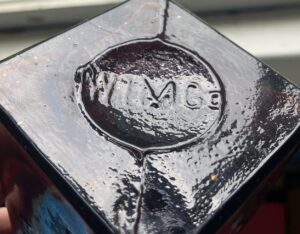
“W I M Co” on base of West India Stomach Bitters bottle (photo courtesy of Miles Burke) - W. I. M. Co. …………….. West India Manufacturing Company. Mark as seen on base of amber “West India Stomach Bitters” bottle. These bottles were made sometime in the 1873 to 1902 period. The glassmaker is unidentified, but likely from a bottle manufacturer in the St. Louis area, such as Mississippi Glass Company or Illinois Glass Company. This article by researcher and collector Ferdinand Meyer V has some good background information about this product: https://www.peachridgeglass.com/2014/08/west-india-stomach-bitters-from-st-louis-missouri/
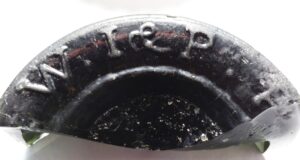
Partial Base Shard of “W. I. & P. Pittsburgh PA” ale or wine bottle in very dark green, circa 1836-1838. - W. I. & P. Pittsburgh Pa …………………Whitehead, Ihmsen & Phillips, Pittsburgh, Pennsylvania (1836-1838). Co-proprietors of several factories in Pittsburgh (located in Birmingham, now called “South Side”), including the Pennsylvania Black Glass Works. Mark is confirmed on the base of three bottle variants, all dark olive green “black glass” or dark forest green porter or ale types. See article by Jay W. Hawkins in All About Glass magazine, April 2011 issue.
- Willington Glass Co. ……………… Willington Glass Company/Willington Glass Works, West Willington, Connecticut (1814-1872). Full name seen on several figured flasks, as well as embossed in a circle (as “Willington Glass Works”) on the base of cylinder whiskey bottles. The flasks might date from the late 1840s into the 1850s or 1860s.
- WIS.G.CO………….Wisconsin Glass Company, Milwaukee, Wisconsin (1881-1886) . [Note: For general information on antique bottles from WI, you might try browsing this collectors’ site. This link points to one page on the site concerning bottles made by Wisconsin Glass Company: http://www.mrbottles.com/Category/WisconsinGlassCompany. ]
- WIS.G.CO. MIL……….Same as above.
- WIS.G.CO. MILW………Same as above.
- WIS.GLASS CO………..Same as above.
- WIS.GLASS CO. /MILW…..Another variation on the above marks. This one is noted on a pickle bottle. (This mark can be misinterpreted to read “Milw Wis Glass Co”, implying the name was “Milwaukee Glass Company”, which would be in error. The company was known as Wisconsin Glass Company).
- W. & J. G. (see “G.W. & J” entry on page three).
- W. L. ……………………… White’s Laboratories, Newark, New Jersey (c. 1940s?) Mark is on the base of a small amber medicine bottle with black dropper lid and original label which is lettered in part “White’s Cod Liver Oil”.
- Wm. Frank & Sons…………William Frank & Sons, Pittsburgh, Pennsylvania (1866-1876). See “W.F.& Sons” mark.
- W.McC.& CO……….William McCully and Company, Pittsburgh, Pennsylvania (1841-c.1909)
- WM.McC.& CO………Same as above.
- Wood /Portobello………….. Wood’s Bottle Works, Portobello, Scotland (c. 1866-1920). This mark recorded on the base of a black glass bottle, probably dating from 1866 to the early 1880s. For more info on this and related firms, please see this article: https://sha.org/bottle/pdffiles/Cooper&Wood.pdf
ADVERTISEMENT
- Woodbury……………brand name seen on the base of many cold cream containers. This indicates Woodbury Soap Company, begun in 1870, originally from Albany, New York, and later based in Cincinnati, Ohio, manufacturer of a variety of personal care / cosmetics products. Most of the typical white milk glass cold cream jars with the WOODBURY marking on the base seem to date from the 1920s-1950s era, but I don’t know exactly when they were first made, or how late they were produced. I have also seen “WOODBURY” embossed on a “beach glass” bottle base accompanied by the makers mark “BALL” in cursive lettering (standing for Ball Bros Glass Company). Many of the Woodbury milk glass jars were made by Hazel-Atlas Glass Company, as their “H over a smaller A” is seen on some of them. There were probably other glass companies involved in their production over the years. This “Woodbury” has nothing to do with the older Woodbury Glass Works, Woodbury, NJ, that made glass fruit jars in the late 1800s.
- Woolfall – Manchester………….. John Woolfall, Glass Manufacturers, Manchester, England (Manchester Glass Bottle Works) c.1833-c.1861. Base markings seen on several heavy, crude black glass ale/stout/wine bottles made in Great Britain. Seen are “WOOLFALL / MANCHESTER” ; “WOOLFALL / MANC’R”; and “(arc) WOOLFALL (straight line) MANCHESTER (arc)PERCIVAL”. There may be other unrecorded variations. Factory name was “Manchester Glass Bottle Works”, but the exact business / firm name changed several times, including “John Woolfall, Glass Manufacturer” (c.1836-c.1838), “Jackson, Woolfall & Percival, Glass Manufacturers” (c.1838-c. 1850), and “John Woolfall & Company (c. 1850-c.1861). Information gleaned from posts on antique-bottles.net (email from genealogy researcher Richard J. Woolfall, Essex, England), newspaper archives on Genes Reunited website, and bottle base photos posted on ebay. Some additional info from genealogy page: https://sites.google.com/site/molwebbhistory/the-history-of-molineaux-webb/people/maria-webb-1794-1871
- Wooster…………….Wooster Glass Company, Wooster, Ohio (c.1900-1904). This plant became part of the Ohio Bottle Company in 1904.
- W. P. G. Co …………….. West Penn Glass Company, Blairsville, Pennsylvania (1890-c.1894). Seen on a picnic (“pumpkinseed”) whiskey flask, and on the base of a clear 1/4th pint shoofly flask (seen as listed on ebay by seller “hwbottles”). Also appears on the base of a Massachusetts milk bottle. Identification of this mark from research by Bill Lockhart.
- W. S. M. C. Co. ………………. Wm. S. Merrell Chemical Company, Cincinnati, Ohio (1880-1930s). Merged sometime in the 1930s with Richardson Drug to become “Richardson-Merrell, Inc”. These initials appear on the bottom of some pharmaceutical product bottles, likely from the 1910s-1930s. I have seen one bottle bearing those initials, but which also bears the mark of Owens-Illinois Glass Co. (diamond and oval) and a date code indicating 1934.

W&T mark on the base of druggist bottle from Rome, NY. (Photo courtesy of Al Parker) - W & T (shown above) ……………… unidentified. Seen on the base of clear, handmade druggist bottle made for “DRS. REID AND STRANAHAN” of Rome, NY.
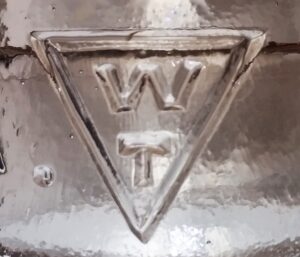
“W & T inside Triangle” mark, as seen on pinkish peach CD 154 glass electrical insulator made by Whitall Tatum Company, circa 1920s. - W above a T, inside an inverted triangle (above)…………………..Whitall Tatum Company, Millville, New Jersey (this particular mark used c. 1924-1938, perhaps as late as 1949 in some cases). This mark is seen on the base of many types of bottles and jars as well as on glass electrical insulators. For more information, please see my Whitall Tatum Company webpage.
- W.T.CO……………..Whitall Tatum Company, Millville, New Jersey (mark used c.1901-c. 1924, possibly later on some bottles). See below.
- W.T.& CO. ……………………………….Whitall Tatum & Company, Millville, New Jersey (mark used c. 1875- c. 1901). Maker of a huge variety of glass containers, especially druggist, apothecary, perfume and cosmetic bottles. The “W. T. & CO” initials are most commonly seen on the bottoms of personalized “slug plate” druggist bottles made for innumerable drug stores and pharmacies around the United States. Whitall Tatum is well known among fruit jar collectors for their “Millville Atmospheric” jar. See more on Whitall Tatum here .

W.T.CO. (Whitall Tatum Company) mark on bottle base shard (Photo courtesy of Jodi Gerstenhaber). - W. T. Rawleigh’s / Freeport, Illinois ……………….for more information, please click here for a webpage on W. T. Rawleigh’s, Freeport, Illinois .
- W.U. (embossed initials seen on a couple styles of early telegraph insulators)…………. Western Union Telegraph Company. The insulators were made by Hemingray Glass Company (CD 125 type) and Brookfield Glass Company (CD 127 type).
- W. Ward (and year date, such as 1994)…………….etched marking seen on the base of hand-made glass bird paperweights. Made by Titan Art Glass, Fayetteville, Arkansas. Also see entries for “Leo Ward” and “Ron Ray”.
- WYETH……………………………………….. large pharmaceutical firm that operated under the name “John Wyeth and Brother” from 1861 to about 1943, thereafter (having been under the ownership of American Home Products since 1931) known as “Wyeth, Inc.”. The business was eventually acquired by Pfizer in 2009. A variety of handmade medicine bottles are embossed “WYETH” on their bases, and most of those may date, in general, from the 1880s into the 1910s. see “J W & B” entry on page three.
- X (two crossed lines, can be interpreted as an X, a cross, or a PLUS (+) sign)……………………. As a solitary mark, often embossed rather crudely in large bold strokes, seenon the bases of many older hand blown bottles and jars, most from the 1850s-1910 period. I believe this is an example of a mold identifying mark. It might have served the purpose of identifying a particular mold in use at the glass factory (especially when a number of virtually identical molds were being used simultaneously) in place of a number. In some cases it may be equivalent to a “shop number” or “shop letter”, identifying the output of a specific “shop” (group of glassworkers within the factory) assigned to produce a certain item. In such cases the worker was paid according to the output of a particular shop. There are many other marks known, including geometric shapes (triangle, diamond, heart, square), star, hash mark/tic-tac-toe mark/pound sign/number sign, spade, clover, Maltese cross, etc,) seen especially on the bases of 1870s-1890s era fruit jars, that might have served a similar purpose: equivalent to a mold number or a shop number. In some cases a mark may have been meant only as a decorative design added to the mold. At this late date, it’s difficult to know with 100% certainty the purpose of any particular mark or emblem of this type. Also, please see my entries on “Star” markings.
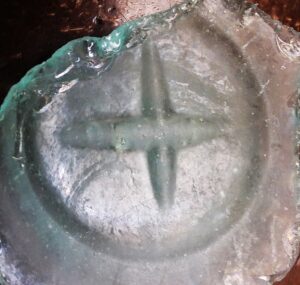
- XXX in vertical formation on machine-made bottles (see “Oil Derrick logo” on Page Four).
- YY. B. Caldwell’s …………………….. please see “Dr. W. B. Caldwell’s” webpage, here.
- Z (as seen impressed into the base of art glass paperweights)………… Zimmerman Art Glass Company, Corydon, Indiana (1963 to present). Most of the paperweights marked with only a “Z” were handmade by glass artisan and owner Joseph Zimmerman in the 1963-1986 time frame, although some might have been made by either of his sons Bart or Kerry Zimmerman after 1983. The “Z” may be accompanied by hand- scratched signatures and year dates. Also, see “B Z” and “K Z” entries.
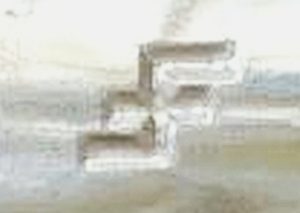
Stylized “FF” logo used by Foster-Forbes Glass Company (Photo courtesy of Krisse Hale) - Z (stylized FF, vaguely similar to a backwards Z with horizontal line through the center)……………………..Foster-Forbes Glass Company, Marion, Indiana (1929-c.2000). (Also, see “FF” entry). This mark is actually a logo composed of 2 capital “F”s connected back to back, the first one upside down, but at a casual glance it somewhat resembles a backward Z with a slash through the center. Mark evidently dates from the 1930s-1940s period; exact time of use is uncertain. If you have more information on this mark, please contact me.
- Zanesville City Glass Works………………………… Zanesville City Glass Works, Zanesville, Ohio (c.1860s-early 1870s?).

Unidentified logo (if you know what company used this mark, let us know!) - Unidentified logo – Diamond (square turned on its side) with “Wave” design in upper section (shown at right) …………………… This appears on a modern, small, clear cylindrical medicine or packer bottle, perhaps made as a decor item. Possibly from a European or Asian glass company?
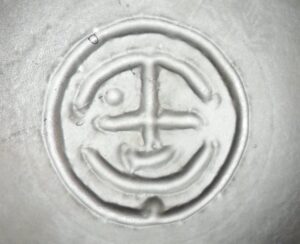
Unknown trademark / logo on bottom of matte frosted glass decor bottle – possibly made in Asia. - Unknown logo (above) – possibly represents an unidentified glass company from somewhere in Asia, such as China, India, Taiwan, Japan, Malaysia or Indonesia? This appears on the bottom of a frosted (“matte” finish) decorative glass bottle, probably 1980s-1990s vintage.
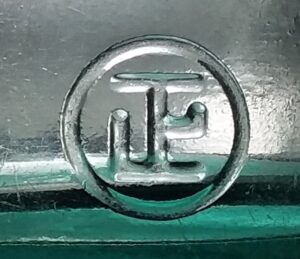
Unidentified trademark on heel of light aqua Japanese beverage bottle – bottle made by Nippon Taisanbin Co. Ltd. - Unidentified logo on heel of Japanese bottle also marked “NT” on the base (for glassmaker Nippon Taisanbin Co. Ltd, Ogaki City, Japan). This might be the trademark of a brand of sake wine, or perhaps a beverage distributor? (See “NT” entry on page four).
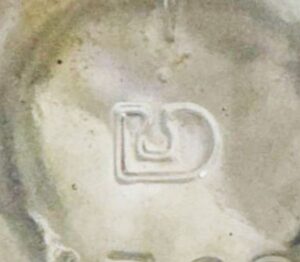
“Stylized D” mark as seen on clear glass packer jar made by DOMGLAS, based in Montreal, Canada. (Photo courtesy of Kayla Verge). - Stylized D mark (above)……………. this was used by Domglas (renaming of Dominion Glass Company, mark used c. 1976-1989). Please see page two for more info.

“Three raised bumps or dots”: Vitro Packaging mark on 2008 Commemorative Coke Bottle. - Group of three raised “bumps” or “dots” (seen on glass beverage and food containers made in Mexico and imported into the US)…………….. Vitro Packaging, Monterrey, Mexico. For more information, please see the “stylized V” mark as used by Vitro, above on this webpage.
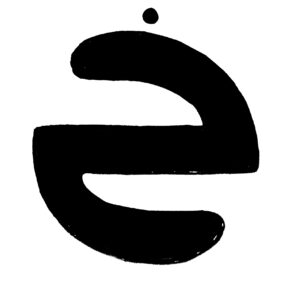
- Logo difficult to describe, but vaguely resembling a compressed backward “S” formed into a circular shape, or a lower case “e” with a gap on the upper left side. (shown above)………………………………. BSN Vidrio España, Alcalá de Guadaíra, Sevilla, Spain. This mark has been seen on the heel of Manzanilla olive jars and other food containers imported to the US. No longer in use, but may date from the late 1990s or early 2000s?

Unidentified mark on handblown bottle with heavy bubbling (Photo courtesy of Mary Ostrander). - Unidentified/unknown mark / signature, as seen on lower side of handmade glass bottle with heavy bubbling in a green-aqua color. The signature is virtually unreadable. I believe the first letter is a “P” but it might be a “D” or an “F”? Age is uncertain, possibly dates from the 1960s into the 2000s? Here are some possibilities of what I seem to see, but none of these make any sense. Perhaps with these “words” included on this webpage, sooner or later a web surfer will accidentally land here and recognize what the name or word is actually supposed to be! If you have solid information on this mark, please let us know and your name can be added to the caption for proper credit. The cursive lettering looks somewhat like: Porogonal, Porguanal, Porquonal, Dorgonal, Porgonal, Porgrool, Dorquool, Porgonol, Porground, Pongood, Dorguool, or Doronal? I realize it is not ANY of those, but what is it? 🙂 I suspect a maker in Central or South America, or perhaps India or China. Someone please tell us!
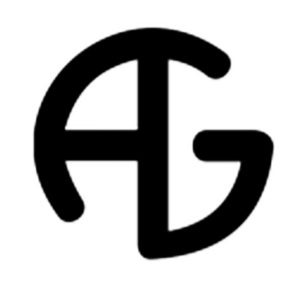
Arcya Glass Corporation, Calamba, Laguna, Philippines and Makati City, Manila, Philippines (1966-c. 2021). Exact timeline for this mark is uncertain. - Arcya Glass Corporation logo (see photo above). I’m listing this here also, as the mark might be somewhat hard to describe. For more information, please check the entry on “Page one” under “AG”.
- IB (BI) monogram, as shown above, may be hard to decipher………….. Ball-Incon Glass Packaging (mark used 1987-1994). Seen on clear glass packer ware.
[ A – B ] [ C – D ] [ E – L ] [ M – R ] [ S – Z ]
Please click here to go to my HOME PAGE.
ADVERTISEMENT

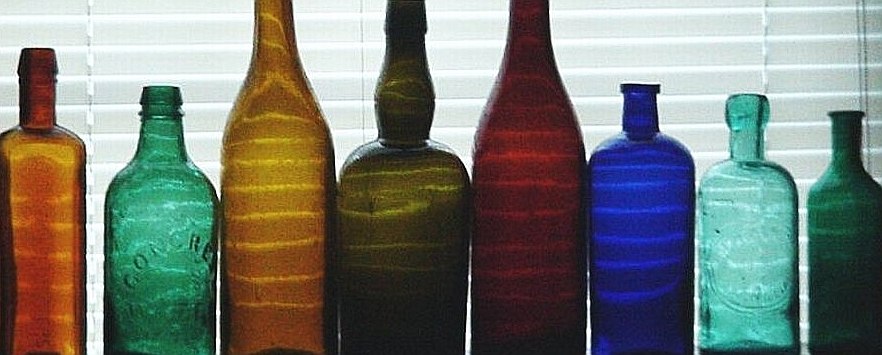
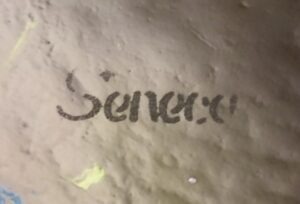
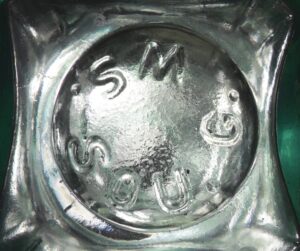
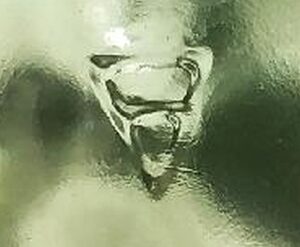
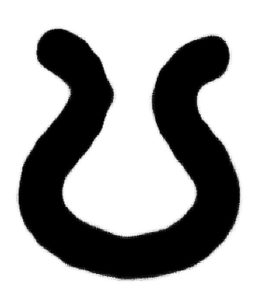
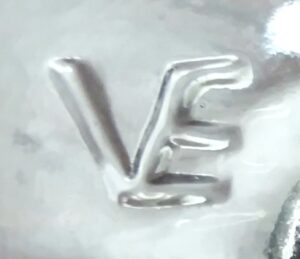
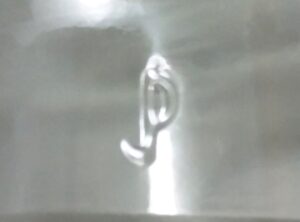
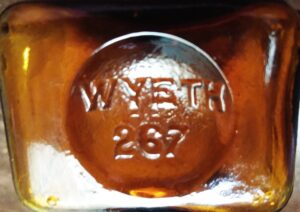
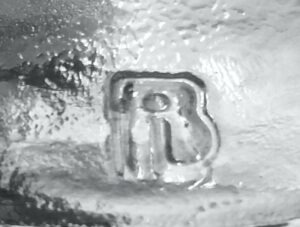
What a wonderful comprehensive list here. Bummer I couldn’t find anything with a trident (also searched the word “fork”). I inherited a bunch of bottles from my Aunt that she obtained from a guy in Australia. I’m on a mission to catalog them all and this is going to be a GREAT resource. I have a greenish amber flask here with no markings on the bottle other than embossed 1842 and a trident on the bottom. Fork facing west. I asked around in an antique bottle forum and they were stumped.
Hi Amanda,
Thanks for your kind words about the site. I hope it will prove very useful for you in your search for information. I sent you an email a few days ago asking for photos of the “Trident” bottle, and have not gotten a response. I wanted to see photos of the bottle if possible. I’m sorry my site is not set up correctly to allow readers to directly upload pics here. Please check your spam/junk folders for my email response. Thanks for your post!
David
Hi David. Thank you for all the work you’ve done in creating and providing this invaluable to resource. I have a blue/green tinted Ball mason jar with sloped shoulders that has a symbol on the bottom I am unable to identify and I was hoping you might know what it is. On the base of the a large number two appears twice and next to one of the numbers is a slightly off axis “X” looking type marking but it looks more like a bow or a pair of scissors even or two crossed sewing needles. Does this sound familiar to you at all? Here’s a link to photos. Thank you!
https://photos.app.goo.gl/zFFNrzo3D21oxvh88
Hello Ivan,
Thank you for the link to your photos. First of all, I will not pretend to understand the several different jar-blowing machines that Ball Brothers Glass Manufacturing Company used over the early years, as the subject is quite complicated and those machines were very complex in their actions and attributes.
But I believe your jar was made on what is generally known as the “Ball-Bingham” semi-automatic jar forming machine. The machine was introduced and used sometime in the c. 1900- 1910 era. A notable feature of jars made on that type of machine is the “round bump that looks like the very top of a large marble sticking just above the glass surface”, visible on the jar base. I think there are usually also two numbers and often one letter, embossed in a rather large, crude style of lettering. There are evidently many jar molds used on that type of machine, with a variety of number-letter combos found on the finished fruit jars. I think your “X” is merely meant to be the letter “X”, or just a mold identifying feature, so that the mold could be easily differentiated from any others installed on the same machine. Here are two links to some archived discussions from 2007, where the Ball-Bingham jar machines are discussed:
https://www.tapatalk.com/groups/balljarcollectorscommunitycenter/ball-bingham-machine-t1081.html
https://www.tapatalk.com/groups/balljarcollectorscommunitycenter/f-c-ball-machine-t1073.html
Sorry I don’t have better info, but perhaps you can find more information with an internet search on the “Ball-Bingham” machines.
I hope this helps! Best regards,
David
Some years ago I come across a clear fish shaped wine bottle. It did not have the label on it, and since my ex got the bottle I don’t know the markings on the bottom.
But, recently I came across another, in green with labels. ANTINORI 1969, a white Tuscany wine made to have with fish.
Markings on bottom are the VE, with a capital H off set.
Hi Donna,
Thanks for your post! I presume you have found the maker of your fish bottle, but I’ll include a link here for readers to their company history page. The bottle was made by Vetreria Etrusca, Firenze, Italy.
https://www.vetreriaetrusca.it/en/company/history
I believe most of their glassware is made in a characteristic light to medium green color. (I don’t know what the capital H indicates). A lot of their decor bottles of various designs have been exported to the United States over the years.
Thanks and take care,
David
I was wondering what this stamp is. The photos of the bottle should be in the last 3 photos.
https://www.flickr.com/photos/141980306@N08/albums/72177720315291112/
Thank you.
Hi Jodie,
Thanks for the link! Unfortunately, I don’t recognize the mark. I am guessing that the mark is that of a glass manufacturer in Europe, possibly in France or Italy. But I really don’t know. I checked several sources including the Emhart Punt Marks site, but don’t see any mark that is similar. I presume the mark is relatively recent, probably dating after around 1980. I really appreciate your post, because with your query and your photo link posted on the web, perhaps someone will drop by (sooner or later) and tell us what this logo stands for!!
Take care,
David
Anything new on the keystone with the letter “V” in it? I have a clear gallon wine jug with this symbol/mark on the bottom of it.
Hi Donald, I don’t know of anything new on that mark. It certainly seems to be somewhat of a mystery!
Thanks for your post!
David
VE Glassware is a company that began in Empoli, Italy in 1920. In 1928, Vetreria Etrusca changed location and became a joint stock company called Società Anonima Etrusca, In 1958, the Cooperativa Operai Vetrai C.O.V. took over the business of Società Anonima Vetreria Etrusca. A complete history to present day may be found here: https://www.vetreriaetrusca.it/en/company/history
vf (punt mark – your remark of January 2021) seems to be a transitional punt mark for Verallia France (Former SG (Saint Gobain)). You can find it also on green 0.75 liter cider bottles. See for French reference: https://www.boboco.fr/blog/comment-un-constitue-un-pot–n94 .
Wowter,
THANK YOU so much for the information! I will update my webpage entry for that mark soon. Take care,
David
Today, Saint Gobain has sold all of their plants in hollow glass. So it’s become Verallia, an independent glass manufacturer with recently a new glass sign – a “V” in a square (https://fr.verallia.com/s/reconnaitre-une-bouteille-verallia?language=fr). The Vf and SG logo will disappear progressively when the molds are remanufactured.
Gaël, thank you very much for the update on the St. Gobain marks!!!
David
I’m having a really hard time identifying the maker of a small medicine (I think?) bottle. The only markings on the bottom are a “6” followed by an obtuse isosceles triangle with a small dot inside near the top point, followed by a small diagonal hashmark/line. Has anyone ever seen something like that?
Hello,
I just had a question on identifying a older Foster-Forbes Glass Company bottle. Do you know around what year a bottle from this company that reads 6 (company trademark) 620 is?
Well wishes, Nicholas
Hi Nicholas,
I’m sorry but I really don’t know about that. I assume the “6” is either a plant location code or a mold number. The “620” might be a bottle style/design code number or catalog number. No info on possible date range.
Take care, David
I have a small bottle with the number 803 on the bottom i have had trouble finding stuff on bottles with numbers i mostly see stuff with all the lettering. if anyone can guide or help i’d appreciate it thanks! 🙂
Matthew, most bottles with just numbers on the bottom are hard to ID if they have no glassmaker mark on them. Please check out my webpage on that subject here: Numbers on the bottoms of glass bottles and jars
Best regards,
David
Hello,
I would be grateful for your help in identifying the maker of a flint glass eye cup embossed “SHT in a lozenge” on the foot.
Many thanks,
George Sturrock (Exeter, UK)
Hi George,
I don’t have any information on the mark. Perhaps a reader can help us out!
Take care, David
I have a glass egg weighing about 15-20 lbs. I was told it was blown by a famous company in Italy. It sits on a base with VR marked with a fancy shape. The base is black, the marking is gold. I can send a picture if you give me an idea where to send it via email or text. Thank you in advance for any information you can give.
Thanks for this info here on this site.found my old w t company pharmacy bottle from Shawnee Ohio.thanks
Hi, I found a glass bottle with the numbers 545 on one side and a 9 on the other. It’s a clear glass and has a few bubbles throughout it as well. Trying to identify it. Thank you
I have matching dark cobalt blue cruet bottles. One has a clear half moon top and the other has a clear full sun crest as the topper. We are trying to determine the maker and value of this matching set. The logo on the bottom of each bottle appears to be one large outer circle with a C in the middle and with what appears to be either a T or a cross in the middle of the C. One bottle has the number 1 on the bottom. The other has the number 2 on the bottom by the logo. Each bottle is 7″ tall, 2″ at the base and opening at top is 1 1/4″.
Thank you for being here!! I am Don and my email is dontice1@aol.com.
Thank you for any help.
This was very helpful. Thank you. I have a small round amber medicine bottle. The only marking on the base is the numbers 1845. Is this the date? And what type of medicine went in it?
Hi Rebecca,
This series of bottles with the number “1845” on the bottom has generated some confusion by collectors. The “1845” is an inventory or style number assigned to a series of bottles (usually in amber glass) that are (what I would call) “generic” cylindrically shaped chemical and medicine bottles. The number is definitely not a year date. They have been found in many sizes from small to quite large. Most of them probably were used for liquid chemicals and cleaning products, and some of them were used for medicines of various types. I think most of these bottles were made by Owens-Illinois Glass Company. I do not know exactly when they were made, but most of them appear to be typical products of the 1930s-1950s time frame. Just for fun you might try doing a search on google or ebay with the keywords “1845” “amber” and “bottle”. This should bring up several results. Hope this helps,
David
I have a bottle that has a cow on one side and the words absolutely pure milk on the other. And on the bottom it has the letters VE A 7 made in Italy and it is corked. Would this be worth anything?
Hi Luann,
This is one of several types of repro or “fantasy” milk bottles on the market. That particular type was made by Vetreria Etrusca, a glass company located in Italy. They were usually sold empty, in gift shops or other retail outlets, as a decorative item or conversation piece. I think most of them were made in the 1960s-1970s, although some may date later than that, perhaps even up to the present day(?). They show up frequently at flea markets. Judging from the numbers of these bottles listed on ebay, they are extremely common and have only minor monetary value to collectors, perhaps one to 4 dollars. However, they are often listed on ebay and other sites at much, much higher asking prices, usually with no bids. They have been found in a range of colors.
Hope this helps,
David
Hello! I have some stemmed, crystal glasses with a “Z” in a square. Any idea what these are?
Lisa, I don’t know. Perhaps a reader can tell us?
Best regards,
David
I found an amber machine-made beer bottle with a crown finish at an archaeological site in Oregon. The base is embossed with a raised “X” and on the side, at the bottom, in raised letters is “WF&S43”. I’m assuming this is William Franzen & Son but I couldn’t find any additional information.
Hi Brennan,
Yes, the W F & S marking indicates William Franzen & Son of Milwaukee. They were a prolific maker of beer bottles. The “43” is a mold or shop number. There are many numbers found on the base of W F & S bottles. The number probably indicates either the mold itself, or the “shop” of glassworkers. I vote for it being a mold number.
There are lots of other beer bottles with the same general type of configuration with a one or two-digit number placed somewhere, usually in the center or lower center of the base.
These include beer bottles marked “A D & H C”, “D O C”, “D. S. G. Co.”, F.H.G.W.” (see my webpage on that mark), “I G CO”, “L G CO”, “M G CO”, “R & CO”, “M.G.W.”, “S B G CO”, WIS GLASS CO”, and others. A hand-drawn pictorial graphic showing some of these bottle bases with various mold numbers is in the reference book “Bottles on the Western Frontier” by Rex L. Wilson, published in 1981.
Hope this helps,
David
The triple triangular logo of American National Can was used around 1986 after Triangle Industries purchased American Can and merged them with National Can. When Pechiney bought them in 1988, they transitioned to the double swirl logo that you also list. This logo was used until 1996 when Ball and Saint Gobain purchased the ANC glass division and merged them with Ball’s container glass division, creating Ball Foster.
Sorry, Ball and Saint Gobain created their joint venture in 1995 and in 1996, Saint Gobain bought out Ball and transitioned the name/logo to Verallia.
Saint Gobain sold the North American glass plants to Ardagh in 2014 after Ardagh had acquired and then divested part of Anchor Glass Container.
Hi William,
Thanks for your posts. I have some of the info on Verallia>Ardagh scattered through this site, but it is hard to keep up with all the corporate changes that are continually going on! I have updated several pages including my page on the Ball Bros Glass Manufacturing Company, the SG mark used by Saint Gobain, and several other entries in the alphabetical mark listings. I’ve also updated the entries on the two logos used by American National Can Company.
Best regards, David
Hello! My daughter was walking in the forest in New York State and found a ordinary shaped green glass bottle no lable but imprinted in the glass is. 12 with the word HORSE under it just at the neck line of the bottle. We have looked every where, but no luck in finding it on the internet. Thought maybe you could tell us the maker is. Thanks so much ! Jeanne Huebner
soaringwings55@yahoo.com
I found a small glass bottle with VICKS and a triangle on each side and on bottom 2(and what appears to be an eye shape)3 and below 20. Just curious if that may be the year? Everything I look up talks about cobalt blue but nothing on clear VICKS glass bottles.
Becky, yes it seems there were several other types of bottles marketed by the Richardson-Vicks company (and I don’t know much about them) however from your description of the markings, your bottle was manufactured for Vicks by Owens-Illinois Glass Company, since their first trademark, seen on millions of bottles of all types, is often described as an “eye” or a “planet Saturn” shape. (See my webpage on Owens-Illinois). The number on the left of the trademark is typically the plant location code, and the number on the right is the date code. The number underneath the logo is usually the mold number.
David
Found one today, small glass bottle marked with John Diamond Philadelphia, PA USA in center a circle with a line intersecting through one part of it. Can’t find anything on that one, any ideas?
Hi folks. I am new to this forum. I found an old ranch dump from the 50’s, and I’ve found some interesting items. I found 3 blue bottles, about 6.5″ high, which I had thought I accurately identified as Bromo Seltzer bottles – 13 oz. However, they are not embossed with the Bromo Seltzer name – so I started thinking I had it wrong. The are marked with the Circle M on the bottom, which I associated with the Maryland Glass co. Now – here’s the thing that’s hanging me up – on the cap, extremely faintly – I can see Sharpe & Dohme on there. Looking up Sharpe & Dohme though, I can’t see the bottles I have found. If anyone might be able to shed some light on this I would be interested.
Hello Vince,
Thanks for your post. I think it might help if I make it clear that Maryland Glass Corporation (who used the “M in a circle”mark) made cobalt blue glass bottles of many sizes and shapes for MANY, MANY different companies over a very long period of time. Sharp & Dohme was a pharmaceutical company that sold gobs of different types of medicines and therefore they had lots of different types/sizes/shapes/colors of bottles made for them, by various glass bottle companies. Some of those bottles bear the initials S&D on the base. Others may have only had a paper label with the S&D name, but with the glassmaker mark on the bottom, or with no mark at all in the glass itself.
I am sure there are a lot of different bottles out there that were made for Sharp & Dohme that may just happen to look very similar to others that were sold containing products from other, unrelated companies, such as Bromo Seltzer. I hope this makes some kind of sense!
Take care,
David
Thanks David for your reply. I have enjoyed your website!
I have a bottle with the same John Diamond markings, looks like an inkwell. Can’t find anything. Were you able to find any additional information?
No I never did. I actually just happen to run across that bottle the other day in my stash and was eyeing it up again because it’s kinda cool. Same for me, looks like an inkwell!
Hi, just wanting to share some pictures of an old W F & S MIL bottle I found today in a rubble pile. See them here:
[Edit by David: The URL supplied which was pointing to Cindi’s blog was no longer working as of 3/19/2021. Here is another page with profile info] : https://www.smashwords.com/profile/view/CindiCSummerlin
trying to identify an old milk bottle with a cross on the bottom. It is square so it fits in a crate with a wide mouth, no screw top.
Trying to identify a mark on glass candlesticks witch is the letter R with a crown above it. Thanks for any direction or comments.
Iola, I don’t know. Perhaps a reader can help.
Best regards,
David
I have 6 glasses with the same mark. A script R with a fancy serif, and a crown on top of the R. Haven’t found the maker yet tho’.
Found it. It’s Rosenthal porcelain/glass. http://www.stylendesign.co.uk/guidepages/entor2.html
Looking for teardrop markings on the bottom of a dark purple vase.
Hi Phyllis,
This reply is over four years late, but scanning through older posts on my site I read your comment again and realized you may be referring to a mark used by Paşabahçe, of Turkey, a glass company that makes tableware such as tumblers. I have an entry on this mark under “Drops/ Droplets” listed on page two of the Glass Bottle Marks pages: Glass Bottle Marks, Page Two. This was info I discovered since you posted your query in January of 2017. I hope this will help! Take care,
David
This is a great site. Thank you! I found what I was inquiring about, which was W _ & S MIL. But, I found a couple of days ago and clear bottle bottom with just 41 on it. Do you know what that is for?
Hi Anita,
They are mold or shop numbers. There are tremendous numbers of bottles of all types that carry only numbers on the base. In the majority of cases, the numbers identify the mold a bottle was made from, but there are other purposes as well. Please check out my webpage about numbers on the base of bottles.
Take care, David
In the section for V over M in a triangle, it refers the reader to “M over V in a circle”. I checked in the M section but I cannot seem to find an entry dealing with that. I found a small bottle with this mark on the base. Can you help?
Glen, it’s the very last “M” entry. I alphabetized that as if the lettering was “M V”. Sorry, my information on that mark is sketchy and currently incomplete!
David
thank you, we found a brown coca cola bottle today with Indianapolis Indiana markings
While fixing the foundation on our very old house I found what looks like a 2noz brown bottle with a capital W then a triangle W over T and a #27 off to the left side Any clue what year made? medicine bottle I’m guessing
Tina, sometime between 1924 and 1938. See my page on Whitall Tatum Company. The “27” is almost certainly a mold number and gives us no info on age.
David
I have 2 Bottling Works glass bottles one clear and one green. I can’t find much information on these because the neck of the bottle is shrunk or maybe just considered it has no neck to the bottle? Someone please help!!
Do you know of anyone who has plant list of bottles/jars with the mold numbers of the Three Rivers Glass Company? I’m looking for a fellow collector. Thanks
Kathy, no, but perhaps someone who lands on this site will have more information for you. (Although I don’t know that such information was saved or could even be available anywhere). Thanks for posting~
David
Found a green bottle with a marks _ x in center looks like cross keys
x x : 28
Tony,
Tony, I don’t have any info on that mark.
David
I found and bottle with embossed s & d and number 112. I noticed your description and was pleased to find history. Now what do I do with it?
Hi David… ended up here doing a search on an old, oversized jar I have marked C.B.M. 656 on the base that was dug straight out of the ashes of the 1930 Crown Hill Fire that almost wiped out Nashua NH. Found your info on that very interesting. I then moved to your information on stars, as I was hoping you’d have some info on a bottle I have with a unique mark. You can see pictures of it at
https://www.antique-bottles.net/threads/weird-makers-mark-simple-bottle.679067/#post-679410
(as I can’t load them here). Some one there thought it may be the City Bottling Works in Louisiana. Ever seen anything like it? Thanks!
Hi Dee,
I checked your pictures of the bottle on the antique-bottles.net site, and I will answer your query on that site also. However, please allow me to note that the star on the base of the bottle, as far as I know, cannot be proven to be related in any way to any particular glassworks. The bottle is a ‘generic’ beer bottle of East Coast origin, the general type was made in many slight variations and the wording “This Bottle Not to be Sold” was a VERY, VERY common “generic” phrase which appeared on hundreds, if not thousands, of different beer and soda bottle variants produced over a long time. Many of the bottles also carried a particular local brand/company/brewer/bottler name. Since yours has only the phrase on the side, it is very difficult to know where the bottle was made or used. That “tic tac toe” type of “star” (as if hand-sketched, in 5 intersecting straight lines) along with the crescent mark, on the base of your bottle is a mark I have never seen, and I think it COULD stand for either an unidentified glassworks, OR it could merely have been a mold identifier (taking the place of a mold number or letter)…….that is, identifying a particular beer bottle mold in use at the factory, where perhaps a number of identical, or very similar bottle molds, were in use.
The “Star” motif has been used in a multitude of ways over many years, being just a decorative device on some bottles, or actually standing for a company. For instance some “WARRANTED FLASK” bottles are believed to have been made by a Star Glass Works of Medford, New Jersey. I have seen those bottles show up every so often on ebay. The Star on the face of those flasks are not at all the same style of star as on the bottom of your beer bottle.
Also… I can assure you that your bottle has NOTHING to do with the City Bottling Works of Louisiana, that info was suggested because there is a lettered bottle posted on a website with that bottling company marking AND with a star on the base (a completely different star, similar to the one used by Star Glass Works of New Albany, Indiana), but the date range of the City Bottling Works eliminates it being from Star from New Albany. (Is this confusing enough yet? 🙂
~David
Hi Digger – I found an old bottle at a dumpsite – with a mark at the bottom that says SUTAX TRADEMARK (all within a large diamond. I cannot find anything on this… any thoughts ?
Hi Michael, I’m sorry, but I’m not familiar with that trademark. I am wondering if that is the exact, correct spelling. Are you absolutely sure of the letters? One letter “off” and it can be impossible (or difficult) to find any info on the web. Also, I believe you have me confused with John “Digger” Odell, who, sadly, passed away in October of 2011. He wrote many books about bottles and bottle values, and hosted a website which still seems to be active (bottlebooks.com) although I’m not sure who is currently taking care of it or continuing to sell his reference books.
Best regards, David Whitten
(Note added 4/11/2022: The bottlebooks.com site is no longer active, but here is an archived snapshot of the home page: https://web.archive.org/web/20120511222523/http://www.bottlebooks.com/
I have a clear glass bottle – 3 sided up to the shoulders, and then circular for an inch. On the bottom is a raised diamond. In it ‘944’, and below the number ‘SUTAX’ – there is no doubting the spelling! Thick heavy glass.
Hello “cledsshed”, and thank you for your post. The “944 inside a diamond” sounds like a product of Illinois Glass Company. But I still have no info on the brand name “Sutax”.
Take care, David
wow , well done , I have been doing a list of john kilner marks and dates , from 1842 to 1937 , from sons to brothers , ltd to co , from wakefield to conisbrough, finding john kilner sons name john kilner then his sons name john kilner , a lot to do and work out ,
Ricky, thanks for your post. What references are you using to establish the list of dates, names and markings? Early business directories? Just curious.
Take care, David
I have a small brown bottle with the bottom marked U.D.CO. R.02 I didn’t find these on your site. Its a great site. thanks ruth
United Drug Company
Great group
I have a very old and crude, black glass Case Gin with a square with an X in it on the bottom. Can you tell me the maker and age by this mark?
Hi Randy, In a word, no. Please check out my “X” entry on page 5 of the GLASS BOTTLE MARKS pages. I assume the bottle dates from sometime in the 1840s to 1880s. But I doubt there is any way to pin down an exact year date.
David
Wondering about a marking on a cut clear glass water pitcher. It is not listed on your site that I saw. The marking is PAT. FEB. 25 1896 W. S. CO
Any information that you could give me on this would be greatly appreciated.
Thanks,
Jessica
Westmoreland Specialty Company.
The double lined T was not used by Thatcher Manufacturing Corp. I have spoken to employees that were here when this Anchor plant (Elmira) was a Thatcher plant and where the headquarters was located. Those I spoke to have never seen that symbol used here.
Lloyd, I would love to identify the true source of this mark. It appears on the bottom of a medium emerald green flat liquor flask (for perhaps gin, vermouth, or a flavored liqueur of some sort??) with what appears to be a date code for 1985. I assumed it is of American make, but now I am not so sure. Thanks for any info you can provide, and also any readers who can identify the “Double lined T” mark illustrated on my Thatcher Glass Company page, please contact me!
~David
[Update – the “Double Lined T” mark has been confirmed to be the last trademark used on bottles made by Thatcher Glass, and I have incorporated that information into my Thatcher webpage]
Ok thank u:)
I have a Vick’s VapoRob bottle I’ve found today and it has the big triangle with the smaller triangle on the bottom.. at the bottom of the triangles there’s the number 27..would that mean that its from 1927?
Hi Shantel,
No, that would be a mold number. It doesn’t identify the year made. On the Vicks Vaporub jars it’s not possible to pin down a particular jar to any certain year.
~David